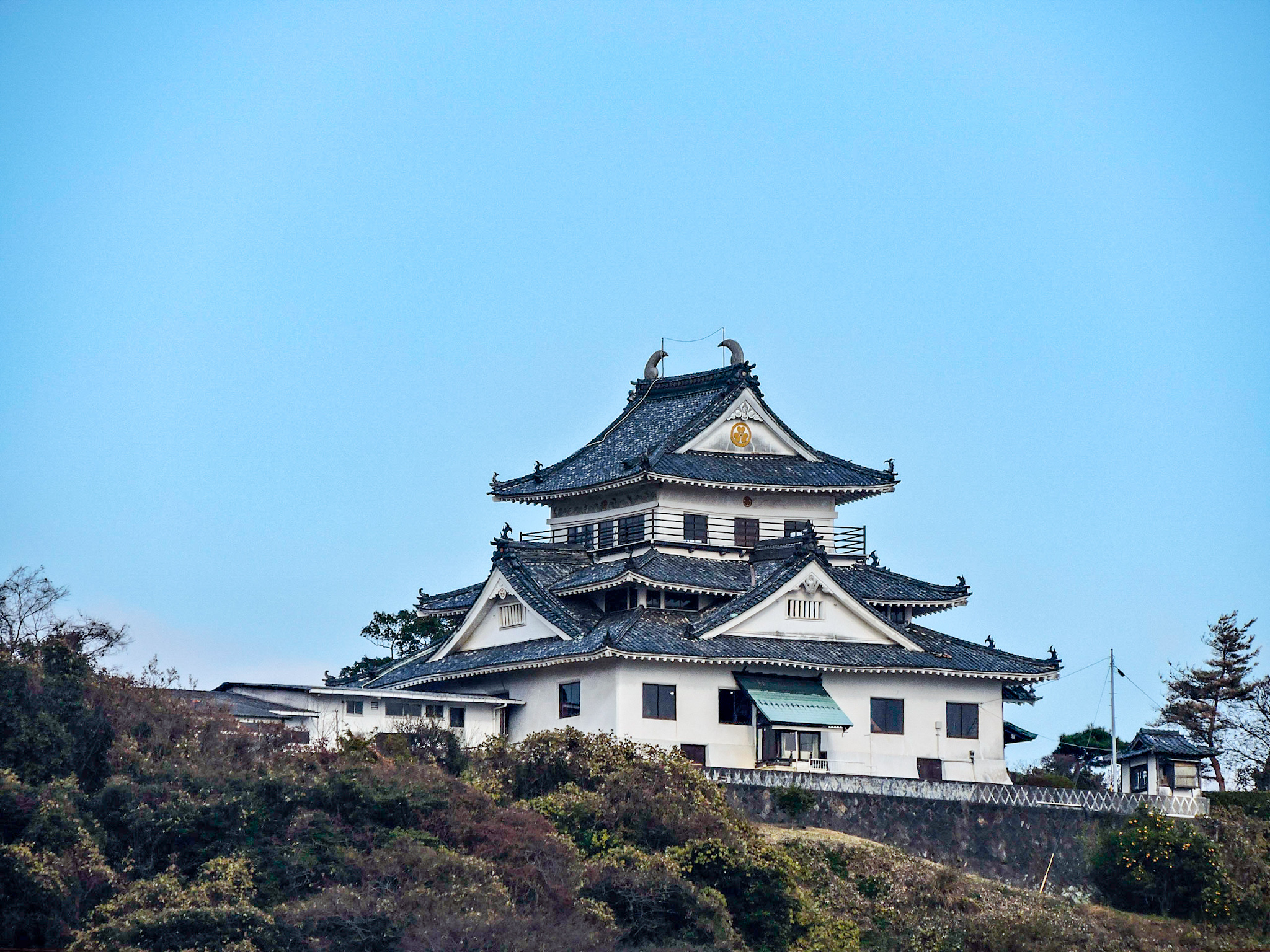
20.12. 2017
We have finally reached the real part of Japan and we are eager to rush to and explore the town of Beppu. It has the most famous hot mineral springs in the country. In the town and its vicinity there are around one hundred baths and springs. In Japanese they are called onsen.
We get free brochures and maps from the ferry terminal by the dock and head to an old traditional neighbourhood known for its mineral baths. Beppu is not small at all. We walk for an hour on the wide modern streets until we reach our destination. Looking at the town the evening before it seemed too square, technological and lacking life but today we start discovering the charming side Japan.
Our first discovery revealed a scary and twisted facet of Japan but we have already heard that the country hosts many flabbergasting and eccentric things. We come in front of a big building, like a shopping mall or something, with a sign saying that it is a gallery of sorts. We peek inside and are shocked to see a big hall where mostly old people are playing manga games on slot machines that produce a cacophony of clattering and roaring sounds. A glimpse inside this place is enough for us and we leave hurriedly.
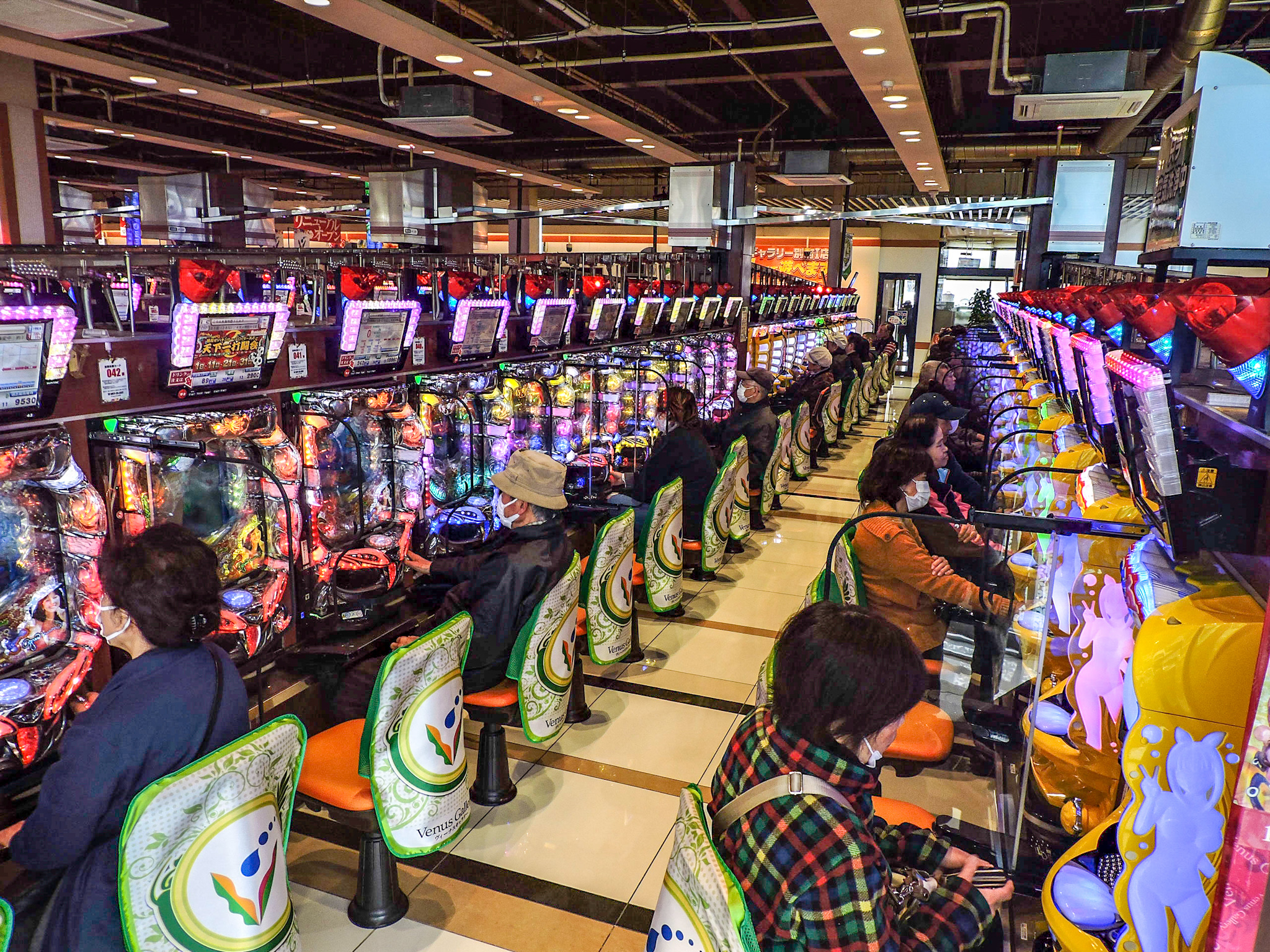 The slot machine hall where old Japanese people are having fun
The slot machine hall where old Japanese people are having fun
Luckily our next discoveries are all related to the well known Japanese zen aesthetics and beauty, e.g. architecture, gardens, temples, poetry and art. We walk alongside modern buildings, luxurious shops and restaurants and then suddenly notice something incredible: a residential building with an arc and stone staircase covered in moss with a small lake inside its yard surrounded by bamboo plants all this resembling a set of “Lord of the rings”; an old wooden house with perfectly planted Japanese pine trees in front of it; or some other random enchanting object or building created in the Japanese tradition of zen. Each detail is very well thought of and perfectly executed with simplicity and mastery. We are somewhat surprised that most people actually live in houses and the big residential buildings are rarely to be seen with the exception of the main boulevard. There are many old houses everywhere but all in great condition and have all the modern amenities inside. The newly constructed houses are built in the traditional architectural style too. Everything is so Japanese here 🙂
 On the streets of Beppu
On the streets of Beppu
We shiver from the cold as we reach the well known neighbourhood Kannawa Onsen with a dozen or more hot springs fuming on its paved streets. Several hundred years ago the Buddhist monk Ipen caught and tamed the surging hot waters and built the baths around which later the neighbourhood formed – at least that is what the legend says. Walking in Kannawa our minds totally block by the surroundings as they get as Japanese as we have ever imagined. Incredible surprises lurk behind every corner.
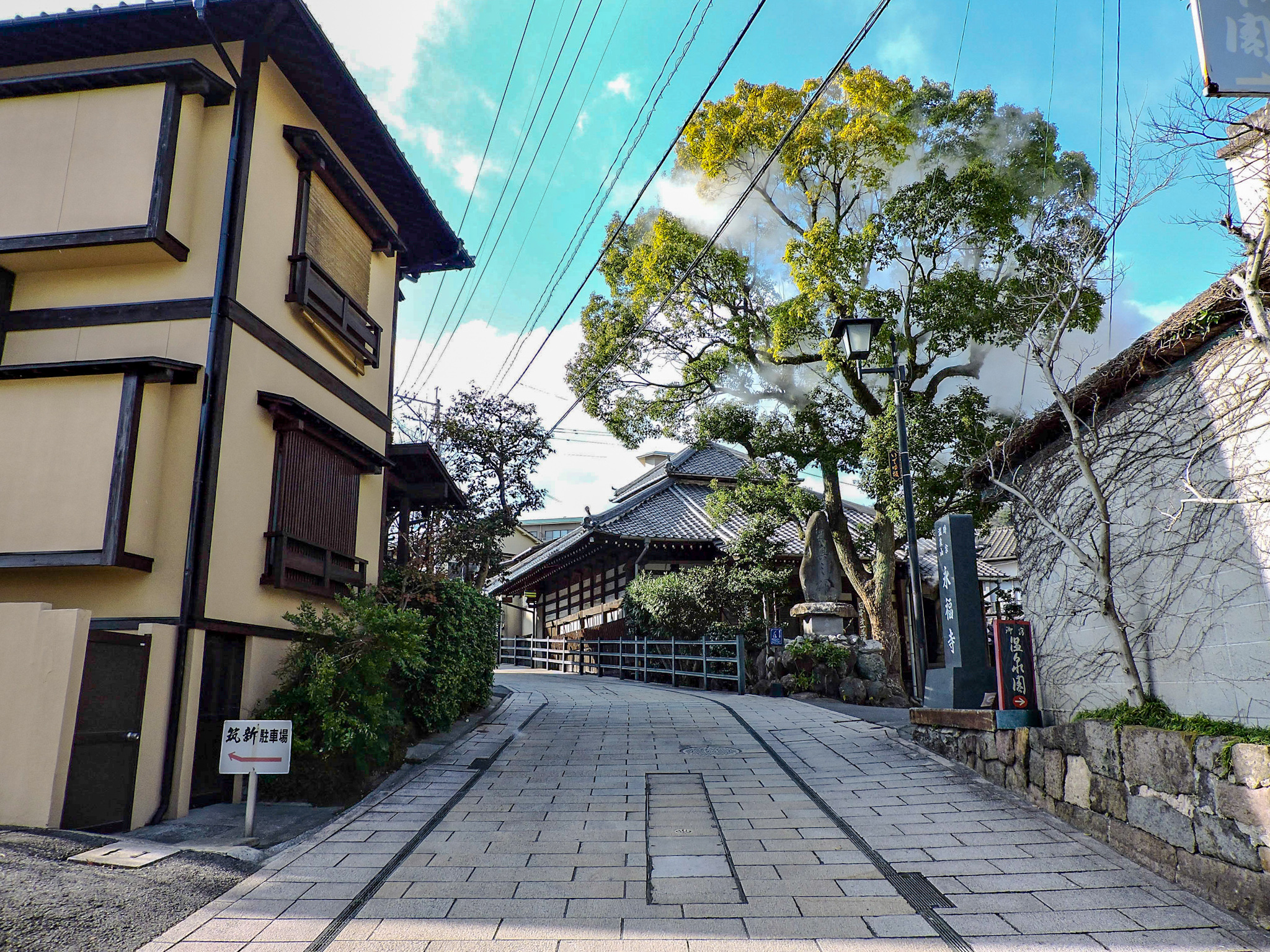 On the streets of Kannawa Onse
On the streets of Kannawa Onse
While we are walking on an old street we notice a small door with a Buddhist alter, donation box and a door on each side which we discover to lead to a traditional neighbourhood bath which is maintained by the people living in the houses around it. It is called jimosen. The admission fee is just 100 Japanese yen (1 USD) and we don’t bring any money on us but are already freezing so we decide to enter for free. There is no one on the door to stop us so manage to get in. In the women’s department there are three women soaking naked in the hot pool. Everything is very clean and nice. As I enter the pool a feeling of ecstasy is taking me over. The women greet me with a nod. The happiness overcomes me bringing me into a state of trance and I start seeing fragments of pictures of our recent walk in front of my eyes : the paved streets, the traditional roofs of the old houses, the pine trees, blossoming despite the cold weather, the fumes of the hot springs crawling up from the street shafts, the always bowing friendly Japanese people…
Feeling ecstatic and inspired in Beppu is obviously happening quite often to people as all around the onsens there are benches and cylindric bamboo boxes where one can insert the haiku they have just written which was probably inspired and provoked by an unbearable feeling of beauty and wonder. After the end of each season the poems are gathered, the best ones are selected and then engraved into stone. These engraved stones can be seen everywhere near the temples or in the gardens.
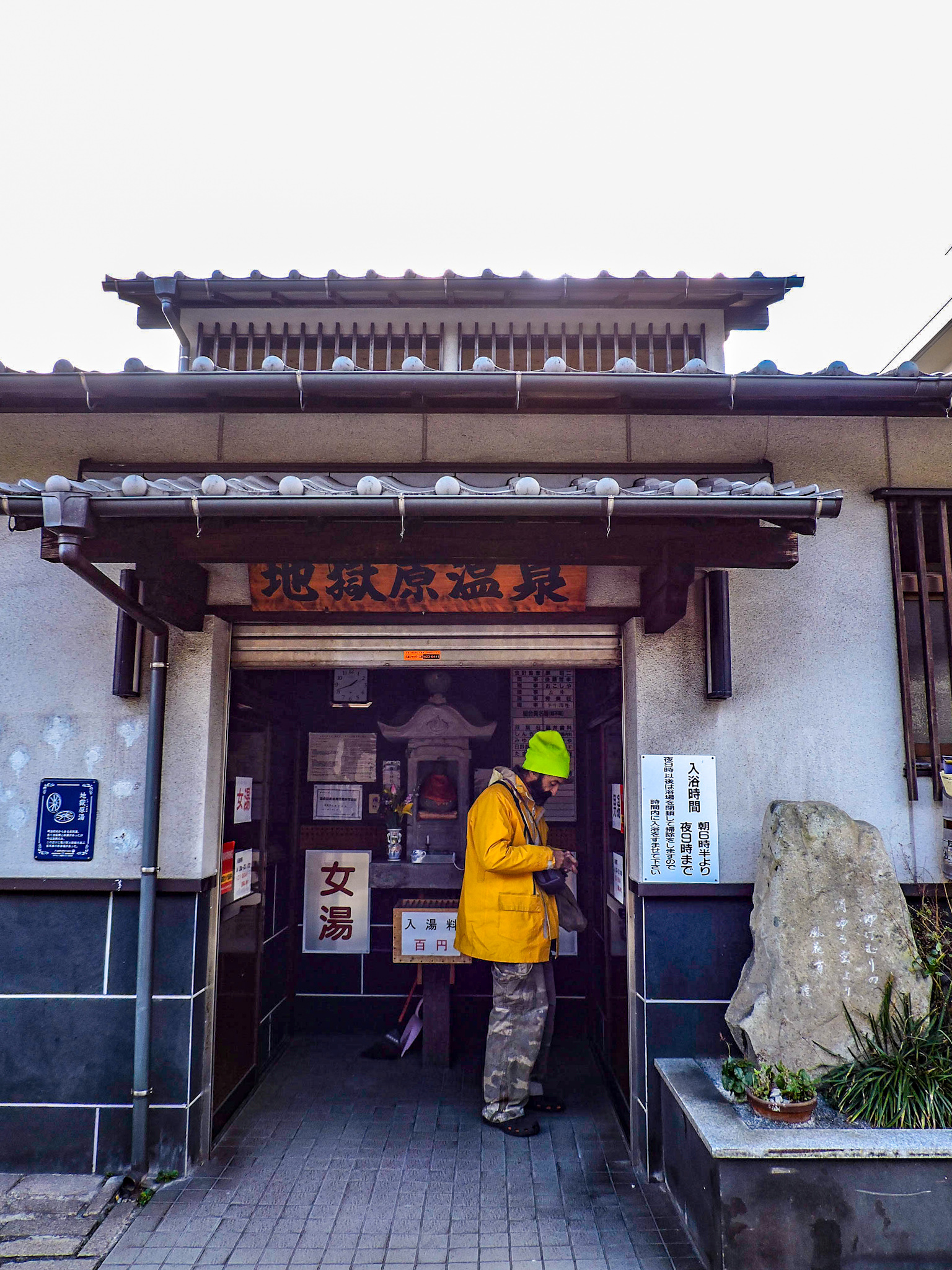 In front of a local jimosen
In front of a local jimosen
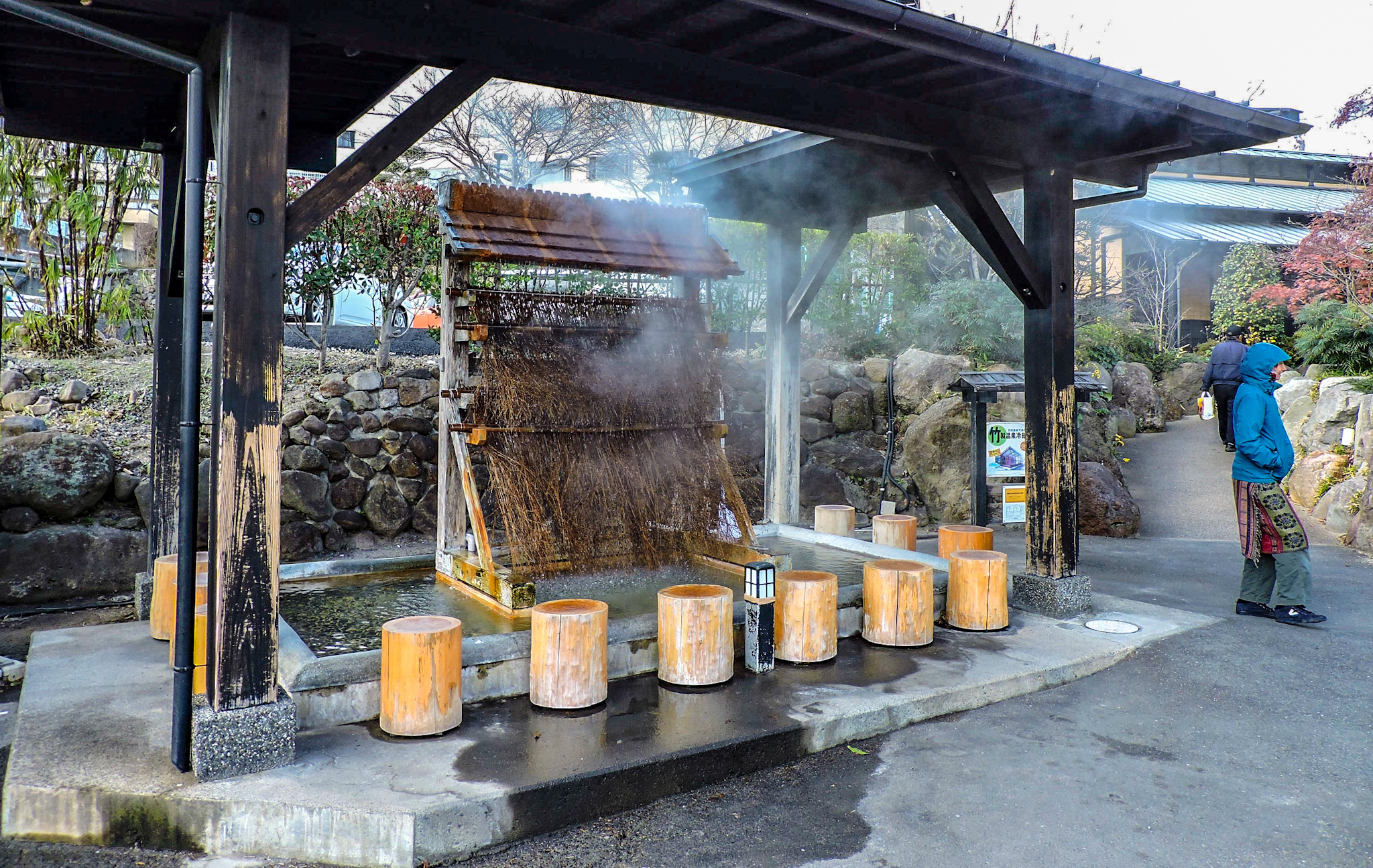 Outside onsen for soaking one’s feet
Outside onsen for soaking one’s feet
After a 20 minute bath we continue walking around the town. Behind every corner there are astonishing things as for example a pavilion which floor is made of marble and is always hot because of the waters running underneath it. The ideas is to sit inside, take off your shoes and warm your feet. Or a wooden shelter with a wooden vessel and chairs. You lift the wooden lid and put your feet inside the vessel for a special healing treatment with aromatic steam bath with herbs. In another place you can pour water over the Ipen’s statue with a small ladle and make a wish that will come true. Or you can go under a specially built roof and cook eggs, potatoes or crabs in an earthen jar sunk in the hot water.
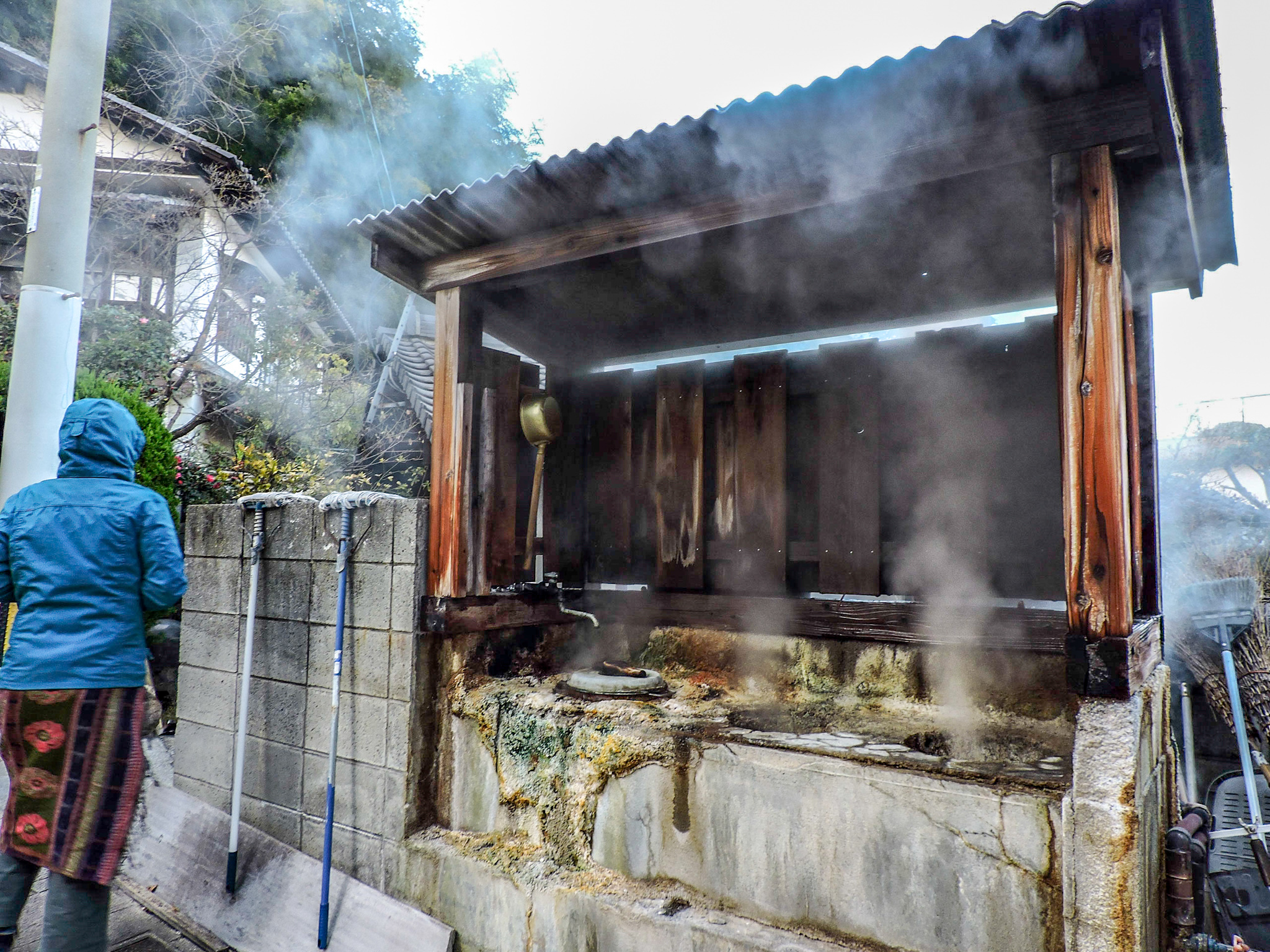 The place people can cook over the hot spring waters
The place people can cook over the hot spring waters
One can also admire the two hundred year old trees in the yard of a Buddhist monastery. Or you can drink healing water with a wooden ladle. There are onsens everywhere (most of them costing around 500 yens to enter) with mud, hot sand, healing straw placed over a steaming spring, saunas and so on. We also found the municipal bath which is free to visit.
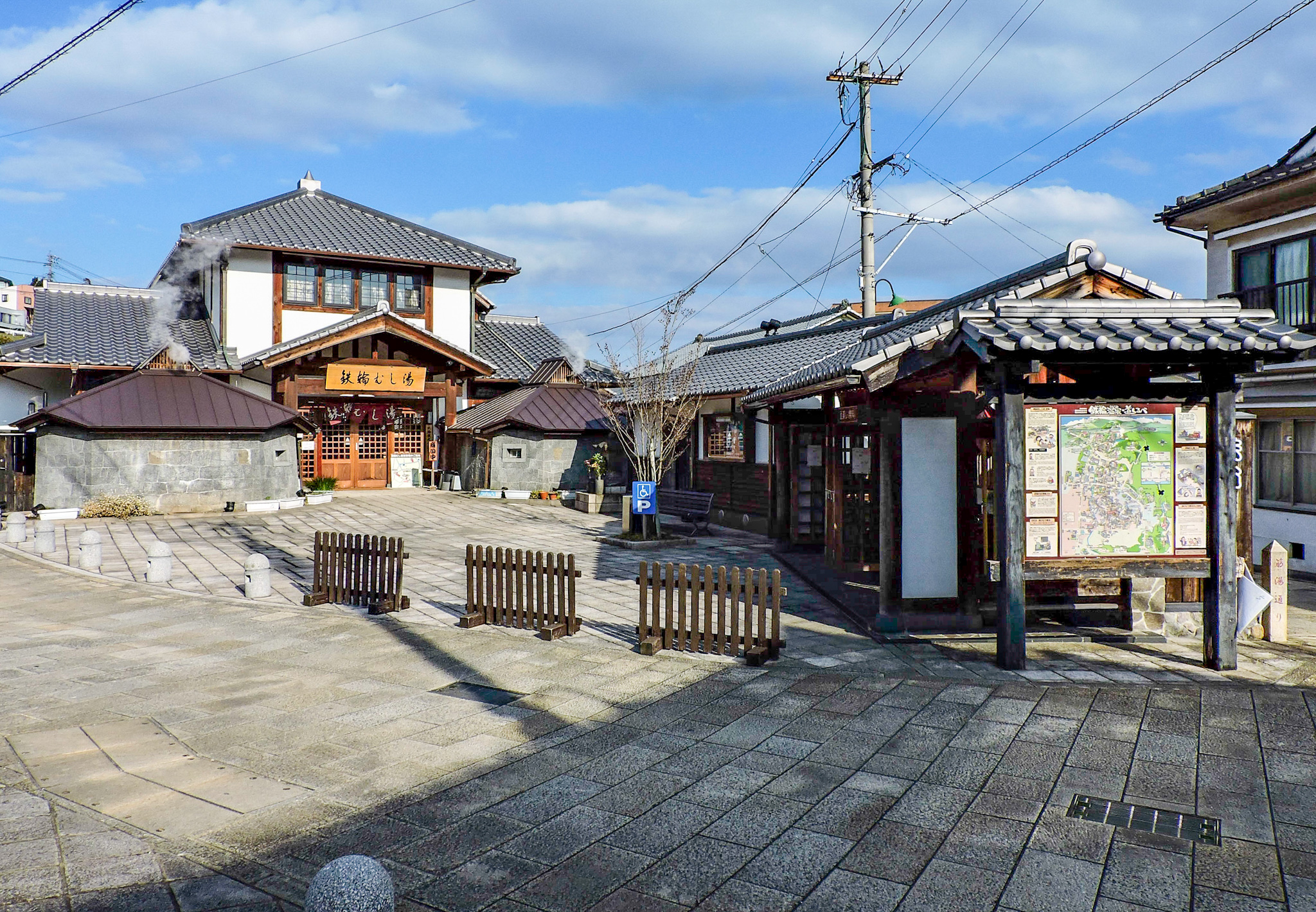 One of the well known old baths
One of the well known old baths
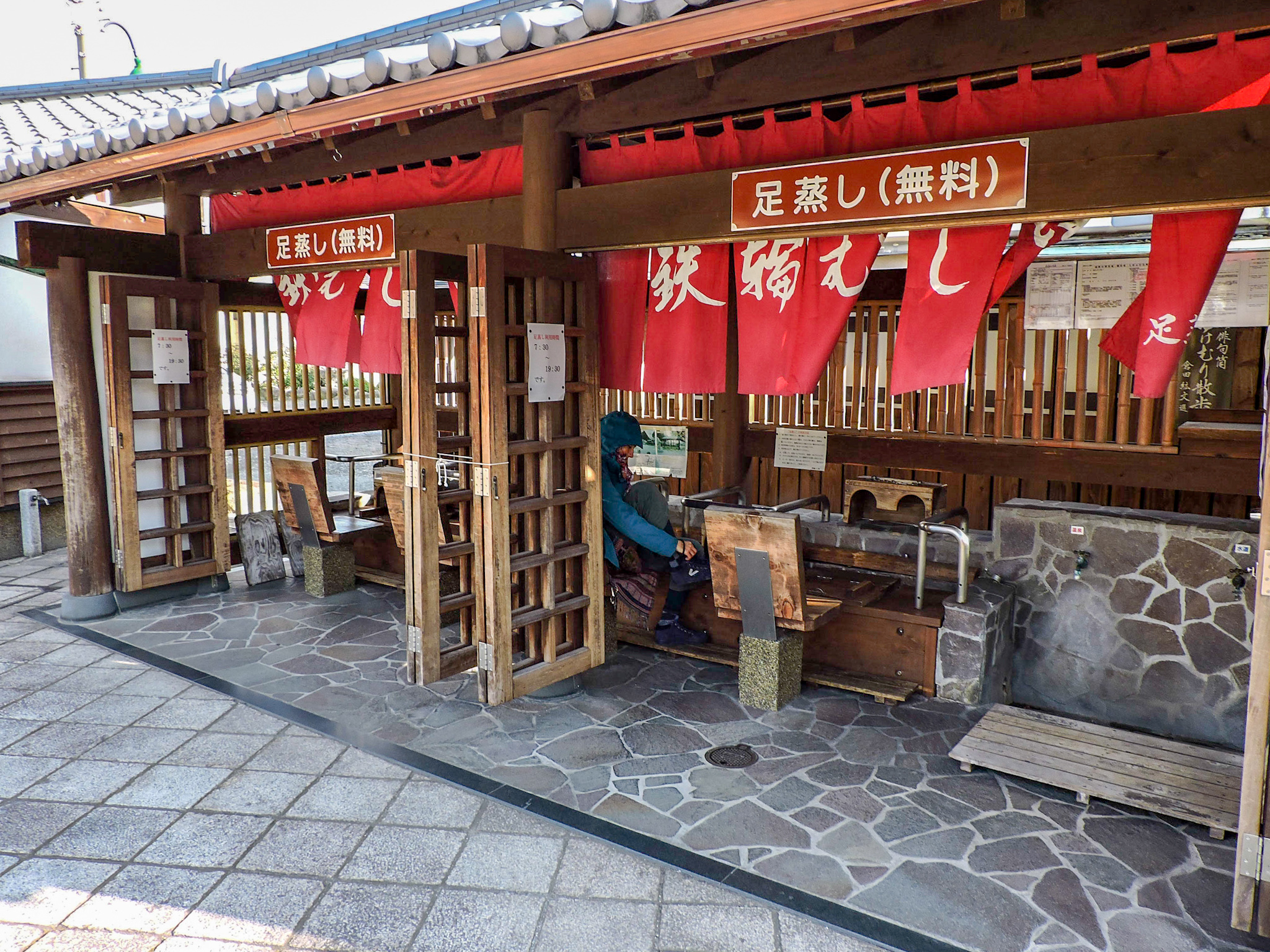 Healing foot bath with herbs
Healing foot bath with herbs
 You put your legs inside and close a wooden lid over them
You put your legs inside and close a wooden lid over them
We climb the mountain over the town and admire the views of the fuming streets. While we are walking around still dazed and amazed we find a wooden pavilion for zen meditation in the forest. It has sliding doors, tatami and pillows. In the front there is a crystal ball with skilfully made dragon woodwork. The pavilion is in the middle of nowhere – an amazing place made for passers by who might be in the mood for meditation.
 The pavilion for meditation
The pavilion for meditation
 Inside the pavilion
Inside the pavilion
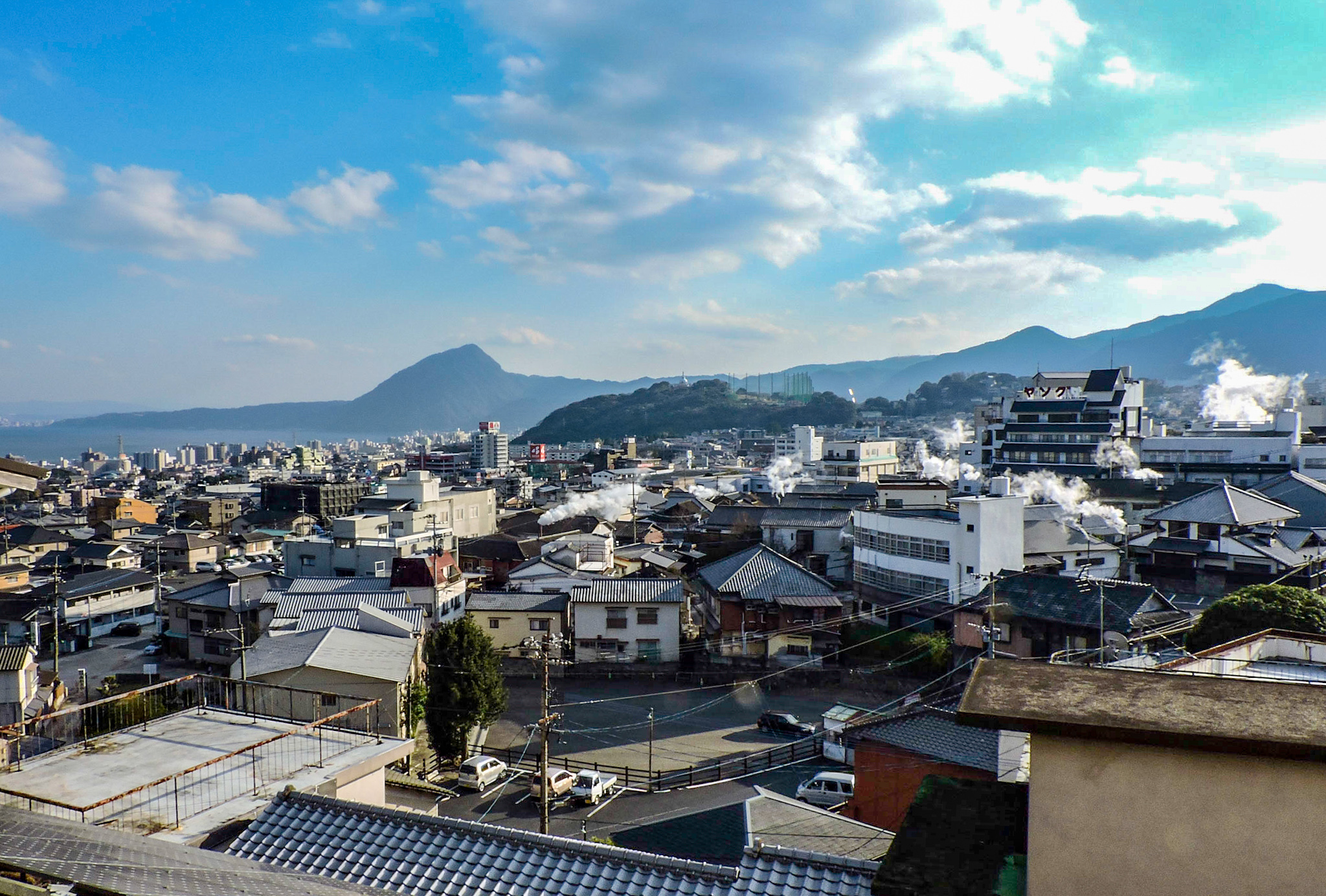 The steaming Beppu
The steaming Beppu
We go back to the town and enter the “Temple of eternal happiness” which belongs to the Buddhist branch of the pure land and is one of the oldest in Kannawa. We watch in amazement the tatami and the ceiling all painted in various flowers, the silk pillows and the golden statues of Buddha Amitabha.
 Inside the Buddhist temple
Inside the Buddhist temple
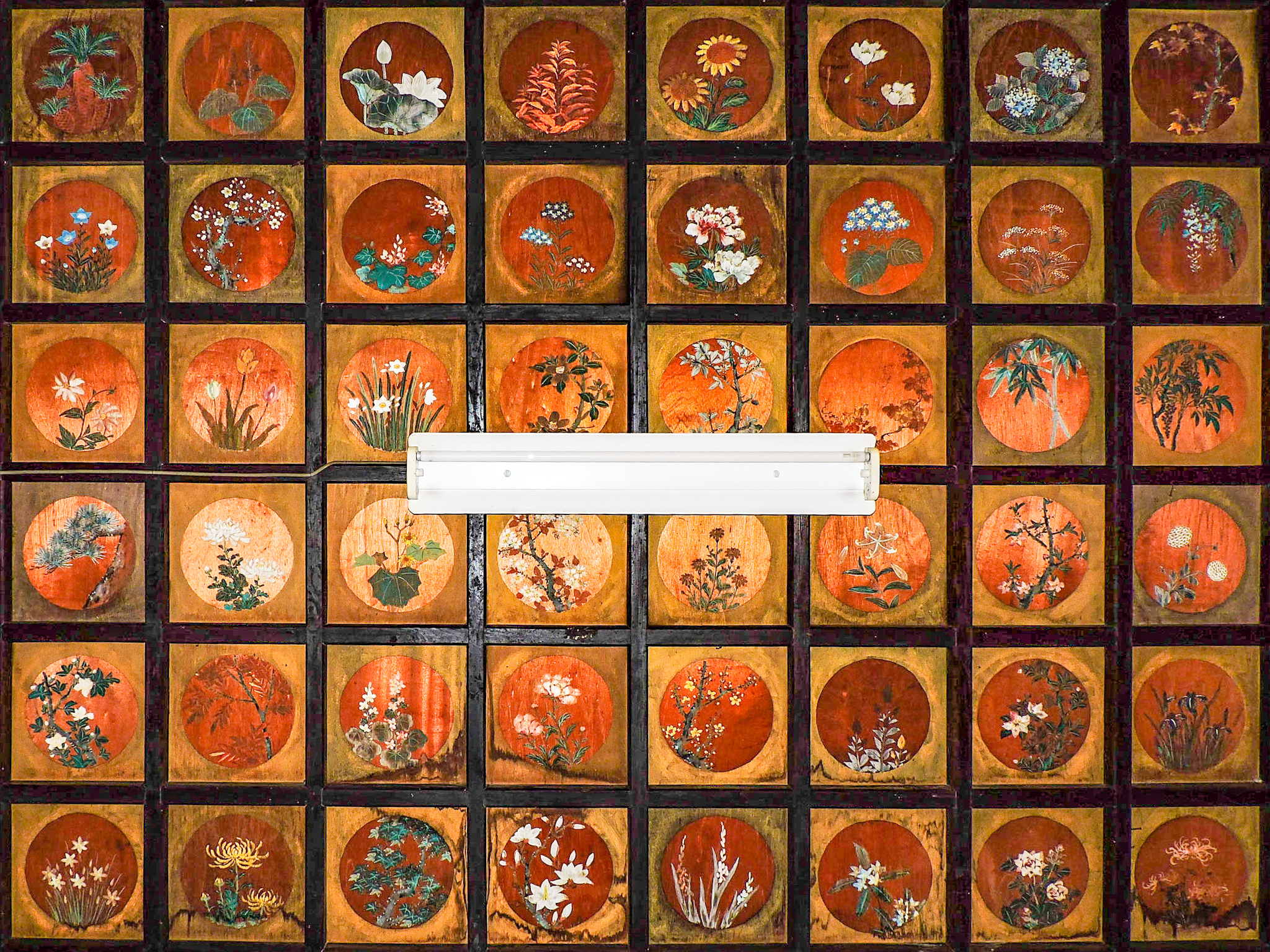 The ceiling
The ceiling
On one of the sides of the temple there is a sliding door. We peek inside and see that this is actually the room of the priest. It has no furniture – just some tatami, a small table with brushes for calligraphy on it and a guitar. There is another room which he uses as a bedroom but with tatami on the floor instead of a bed. It is unbelievable to us how all the ideas and images we had about the way the traditional zen Japan looked like became true and we could now see it with our own eyes. Soon the priest himself comes and starts telling us about their branch. Their tradition ordains that one gets enlightened by repeating the name Amidha Buddha as a mantra. It is believed that if you can say the name even just once but with a pure heart you will get enlightened. The priest is very nice and when we tell him we come from Bulgaria he immediately relates it with yogurt and the sumo champion Kotooshu. This in fact is what other people here associate our country with. In every supermarket there are various yogurt brands that say are licensed in Bulgaria.
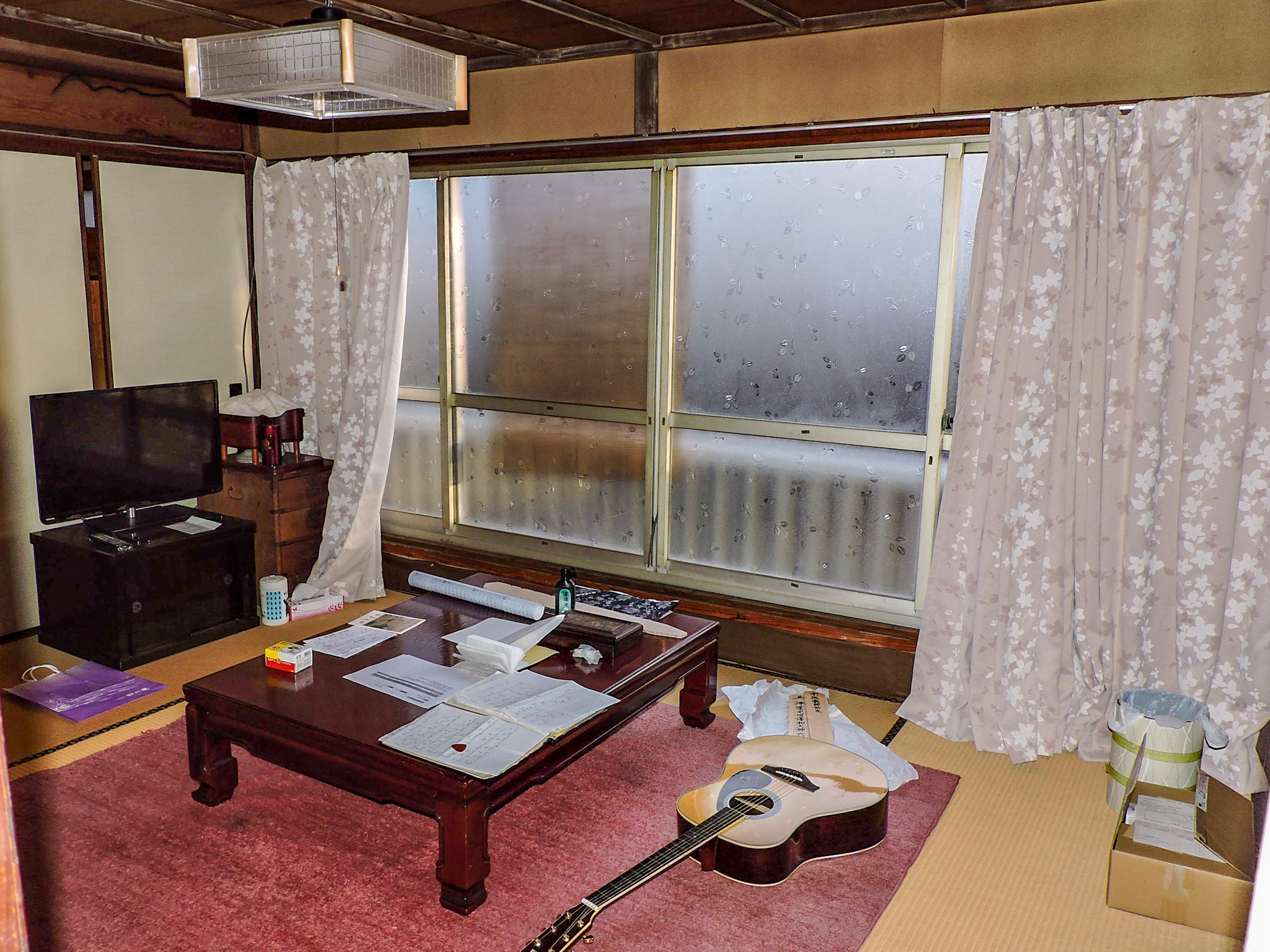 Typical Japanese room with very little furniture
Typical Japanese room with very little furniture
 A temple
A temple
 Another temple
Another temple
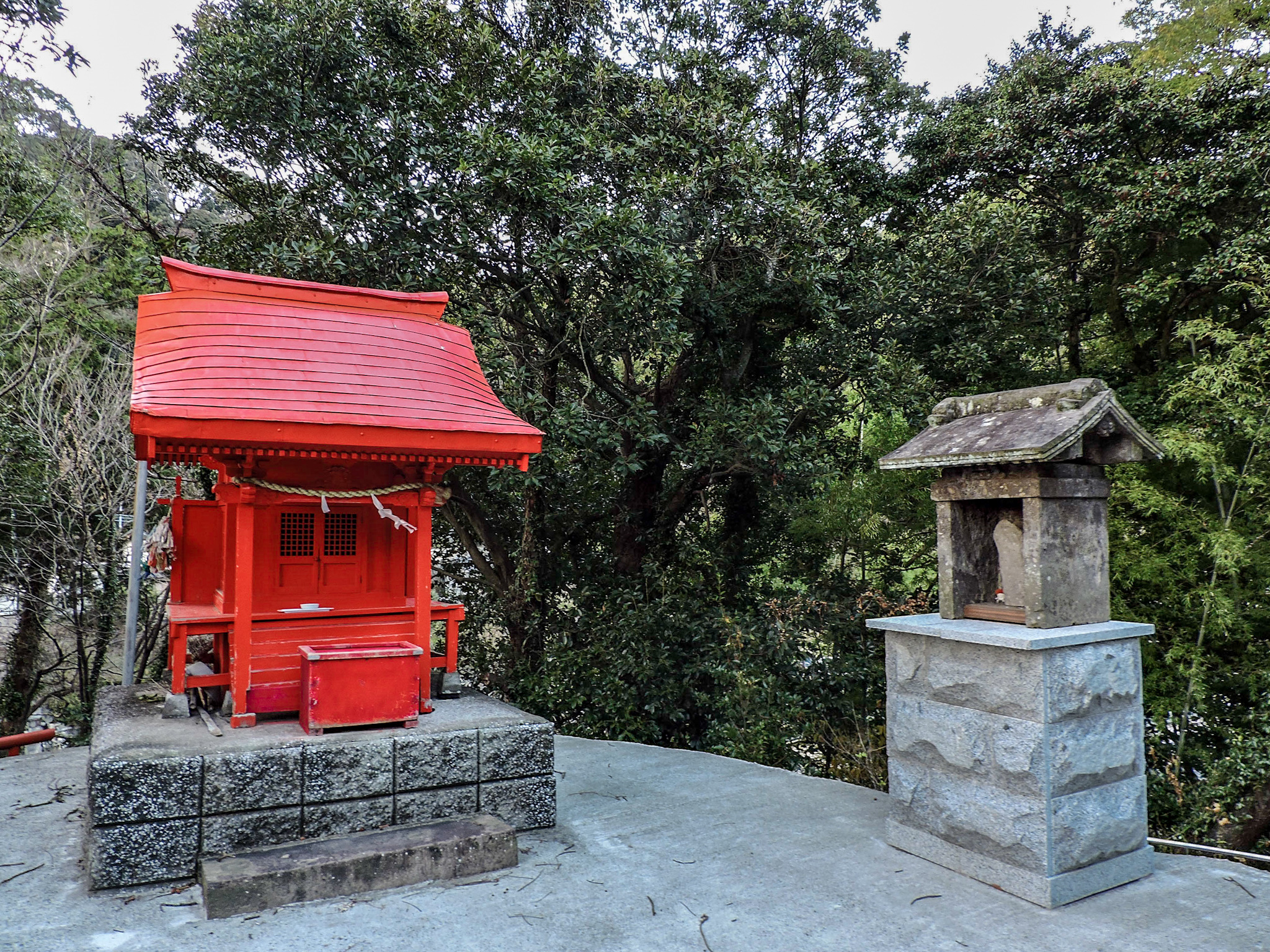 Shinto sanctuary
Shinto sanctuary
Our trip comes to end in the town visiting the so called “Nine hells of Beppu” – these are beautifully designed gardens situated around various mineral springs that are too hot for bathing. Each has a different colour varying from white, red and yellow to green. The entry fee is 500 yens. Anyway we arrive out of its working hours and there are no guards so we enter. It is pleasant to walk inside where we are amazed by a blood red smoking lake.
Before we go home we decide to visit some of the other local onsens in order to warm up before the long walk home. One of the women we meet inside gives me a traditional mochi sweet with a filling of sweet soya cream. Japanese people turn out to be very friendly and generous and always give you foods and drinks.
 Hot spring
Hot spring
We go back to our boat “Alabama” to meet Aska who came back from Tokyo where she went three weeks ago to attend her sister’s wedding. She also intended to help deliver another yacht to Korea but then decided to come back and leave the delivery to Marchelo. It is her birthday today and celebrated it with pies, brownies and sochu – alcohol made of barley.
 Traditional earthen jars for sochu
Traditional earthen jars for sochu
21.12
Mr. Windy has prepared us a surprise. On the occasion of our successful arrival in Beppu he has sent us money to rent a car to see around and some more money to go and treat ourselves in a restaurant. We decide to visit the historical town Usuki which is 50 km away from Beppu. Early in the morning we are already driving by the coastal villages. To our surprise all of them are with traditional old houses. We can’t believe that the super modern Japan has such well preserved culture. Usuki is a historical town surrounded by fortified walls and inside it there are ruins of an old castle and a samurai neighbourhood with dozens of well preserved ancient houses that are still inhabited by people – probably the samurai’s descendants.
 The castle in Usuki
The castle in Usuki
Interesting to know…
Kyushu island was one of the islands with most samurai and also the place where this military stratum lasted the longest – till 19-th century. The castle in Usuki was built in 1550 by the feudal lord Otomo Sorin also known as Don Francisko or the “Christian samurai” who was converted to Christianity by the missionary Fransis Havier.
In 1600, not far from Usuki on Kuroshima Island, arrived William Adams – the first British person to set foot here and also the first European to be given the title samurai because of his knowledge of marine navigation and his successful integration in the Japanese way of life. He received the title by Tokugawa Ieasu the Shogun himself. The events that happened here back then is also described in the book and the series “Shogun”.
 Streets in Usuki
Streets in Usuki
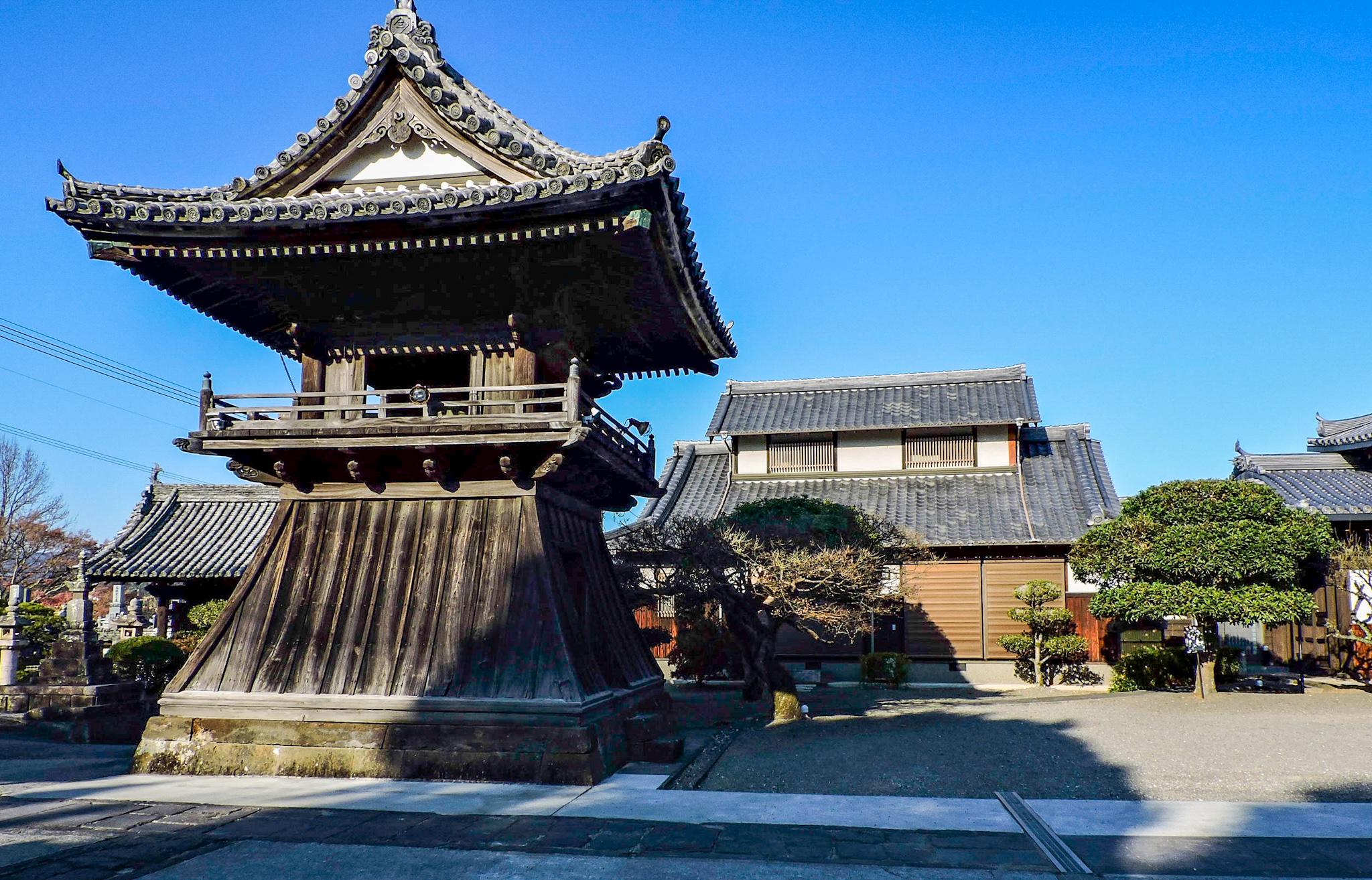 The bell tower of a zen temple
The bell tower of a zen temple
We are so thrilled to walk around the castle and the places where our imagination has roamed many times while reading the book “Shogun” so many years ago. If back then somebody had told me that one day we will visit this place I wouldn’t have believed them. The old town is quite impressive and is filled with Buddhist and Shinto temples as well as old stone houses with their typical traditional curved roofs. We walk around zen gardens, paved streets and house-museums. One of the most impressive buildings was the family home of the influential Inaba family surrounded by canals. The Inaba had ruled Usuki for almost 300 years (1600-1871).
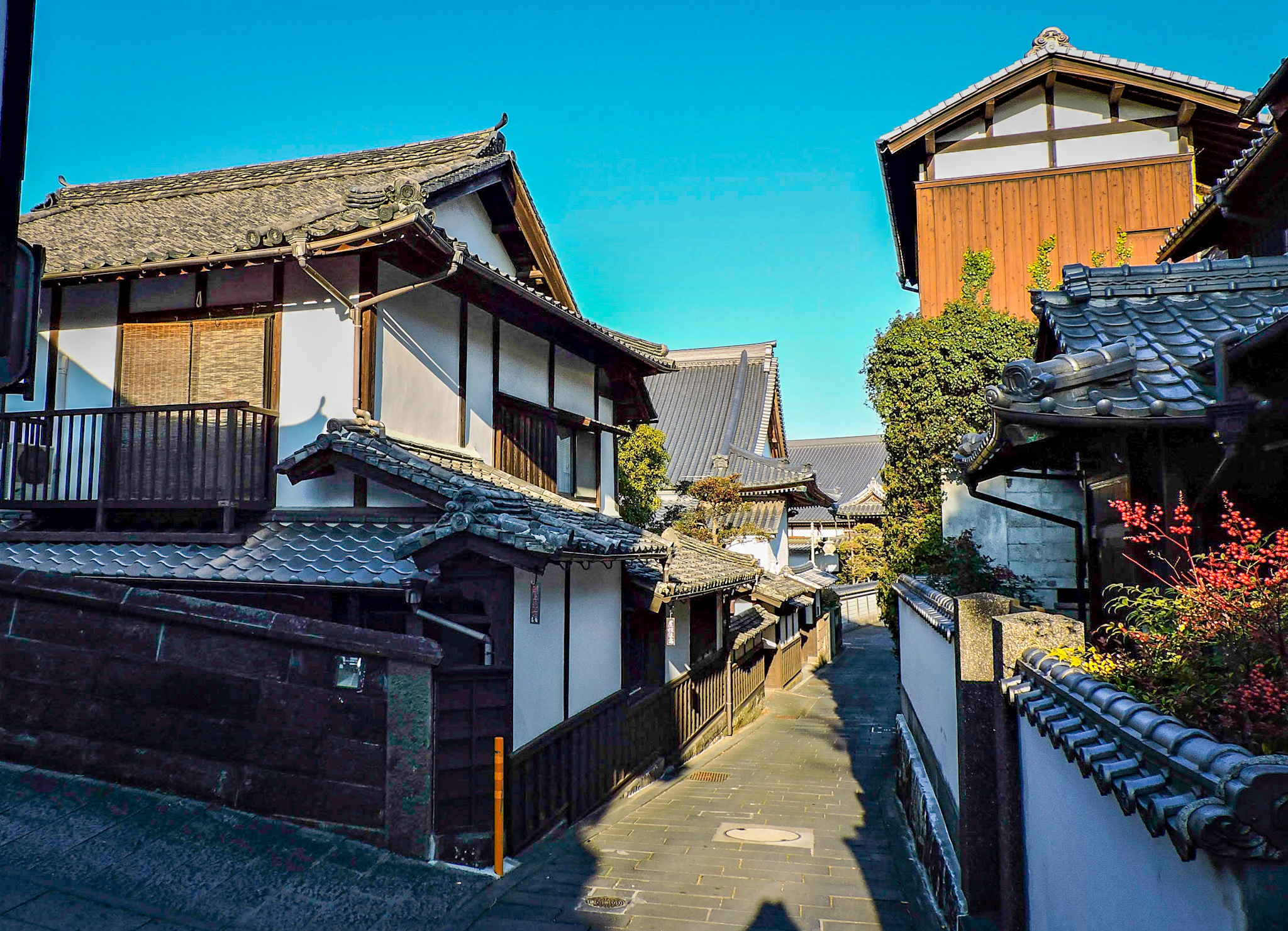 A street in the town
A street in the town
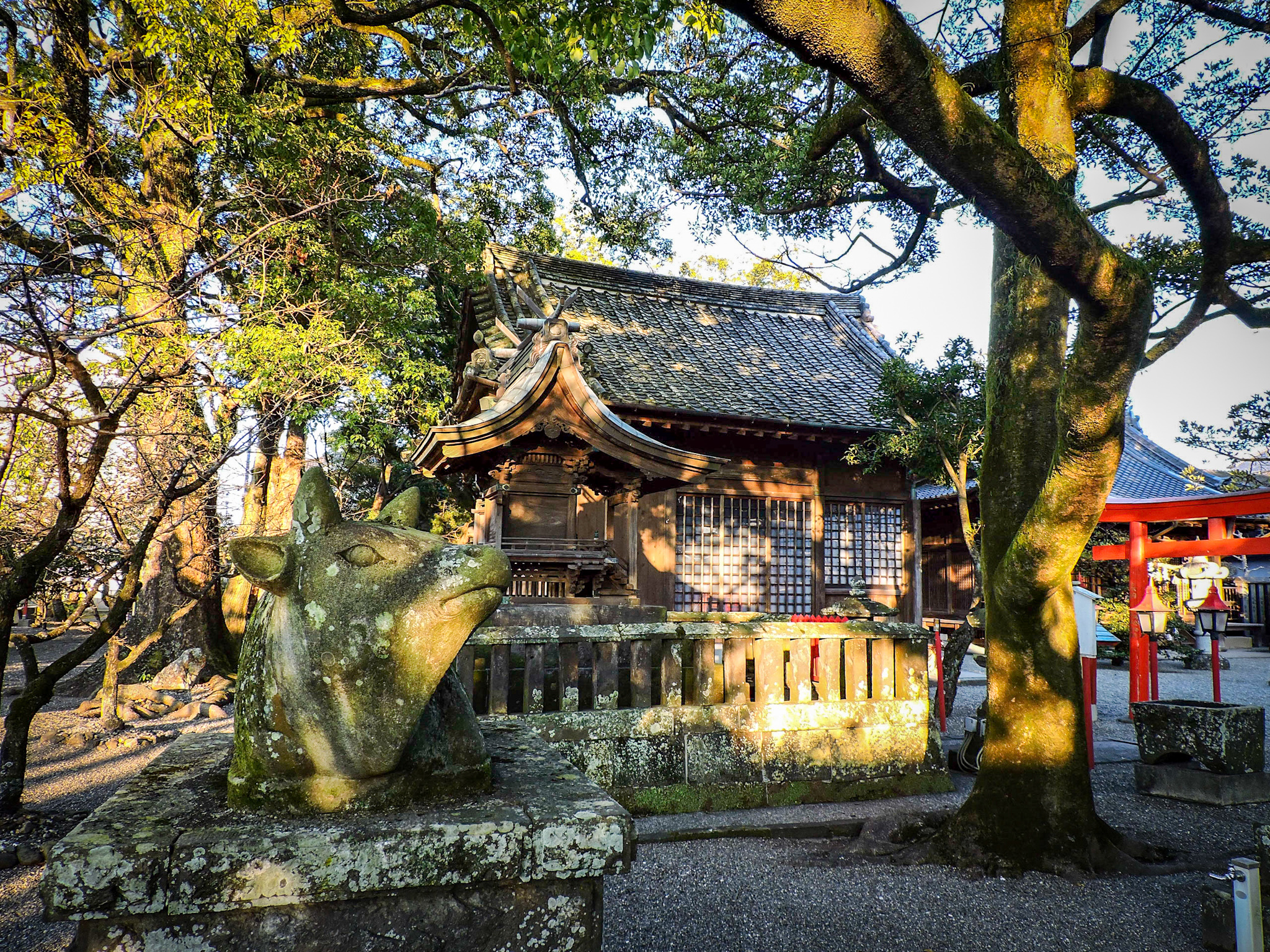 Shinto sanctuary
Shinto sanctuary
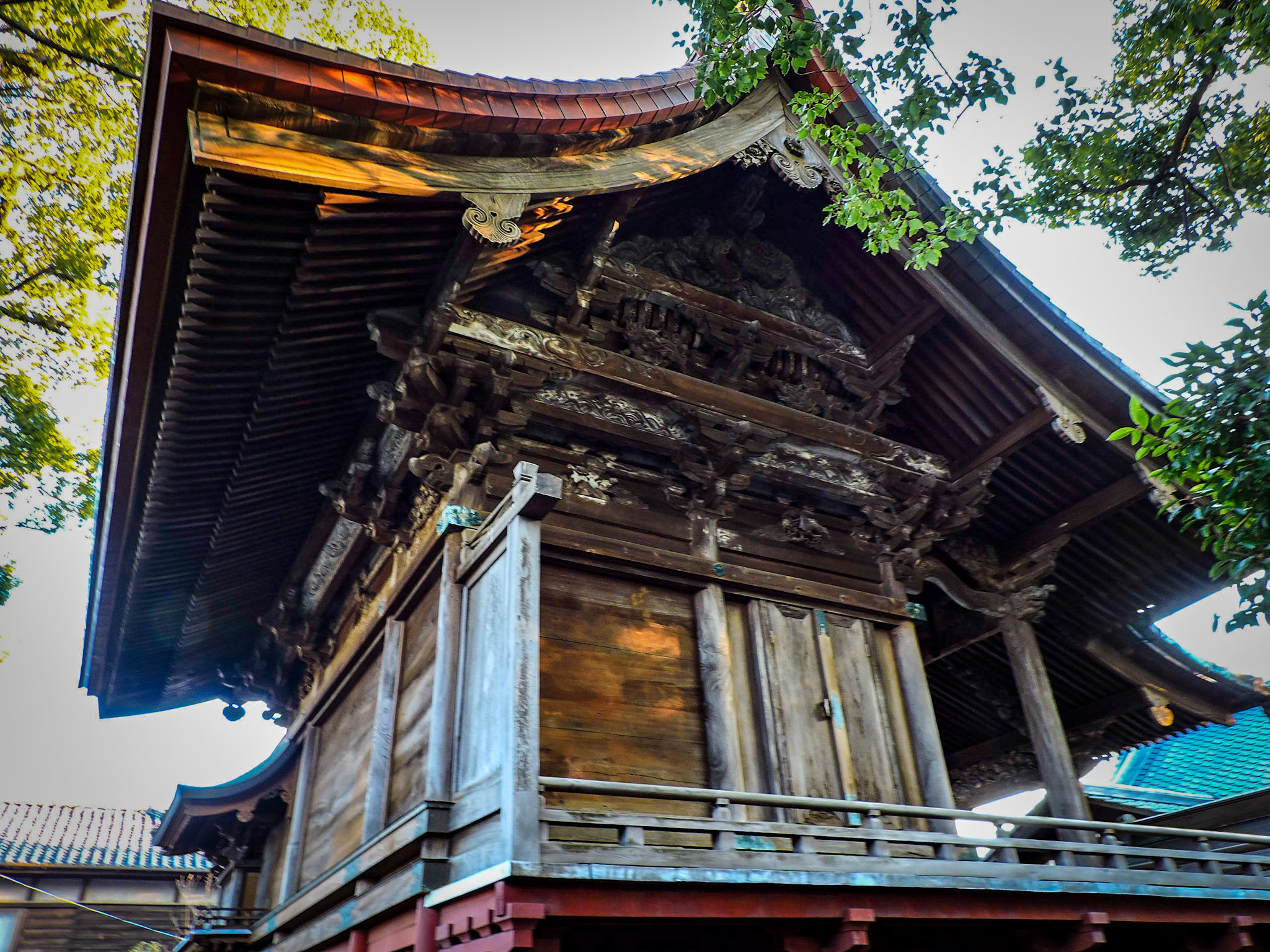 An old temple
An old temple
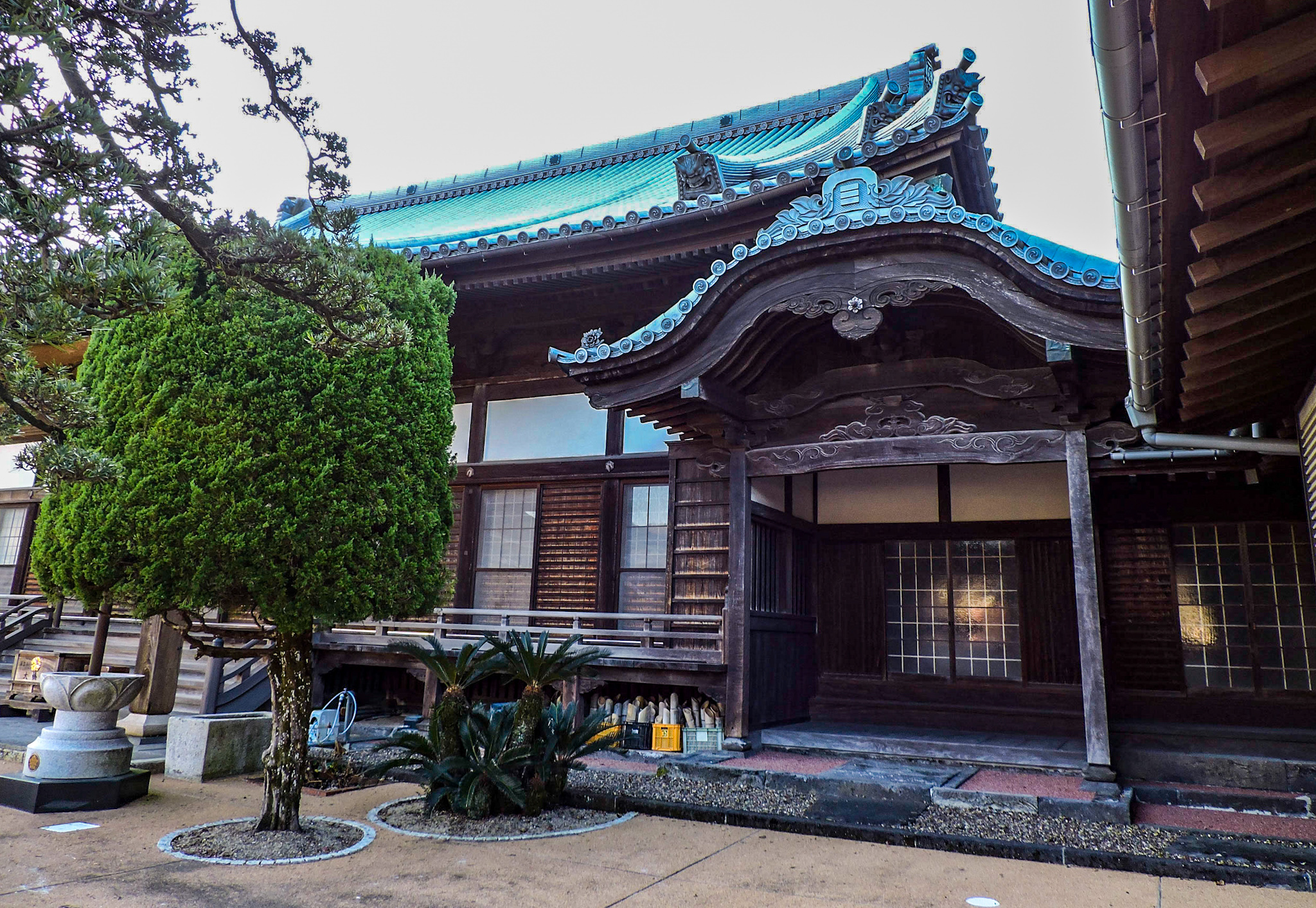 Samurai house
Samurai house
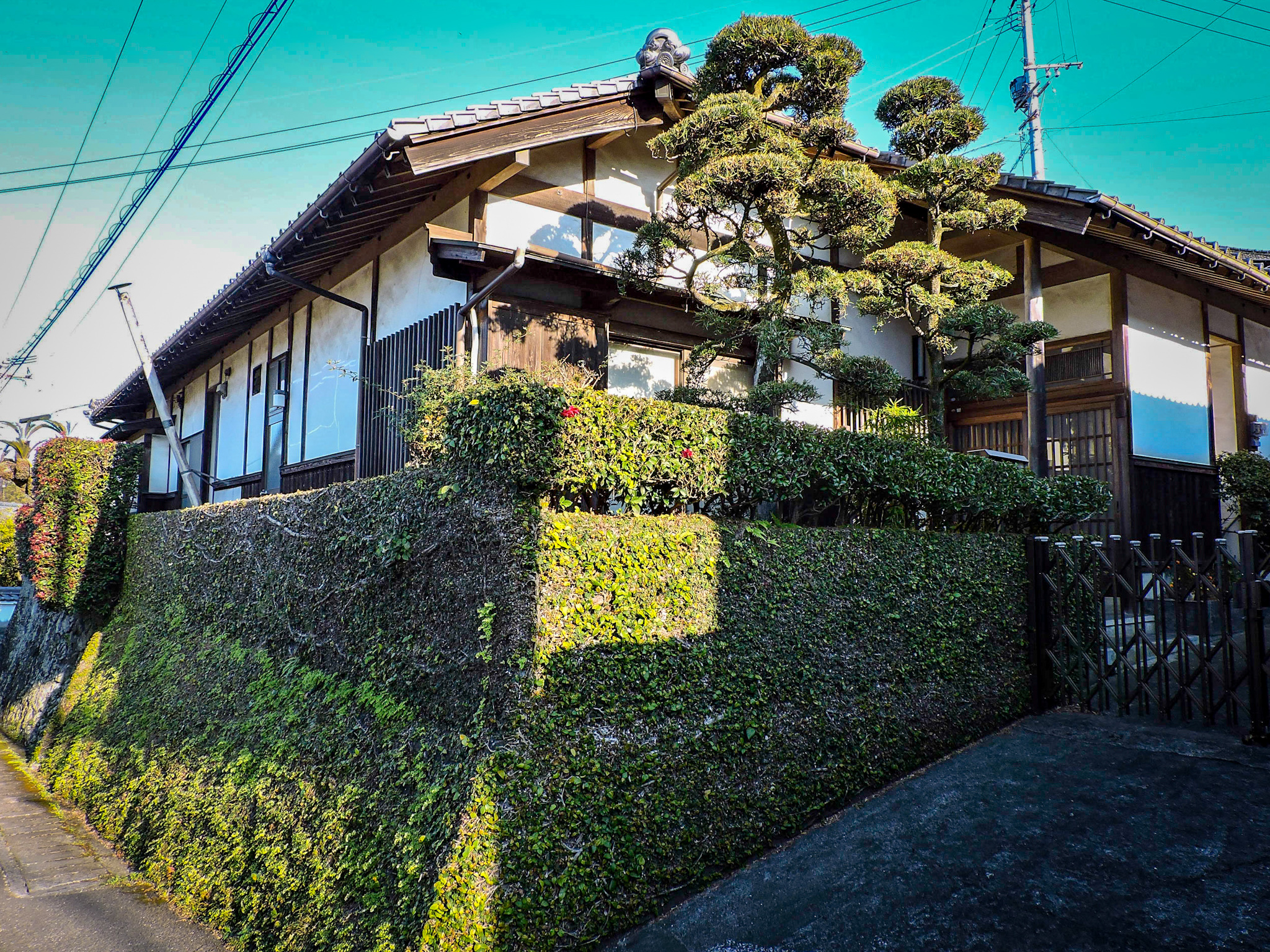 A house with trimmed Japanese pine trees in front
A house with trimmed Japanese pine trees in front
We enjoy the place walking on every street of the village, visiting several samurai museums one of which has tatami all over the floor and a preserved traditional cauldron for cooking over the fire. Its windows are looking at the specially arranged trees so one can get inspired when sitting on the calligraphy table. It starts to get dark and we are already freezing.
 The calligraphy table with the special view
The calligraphy table with the special view
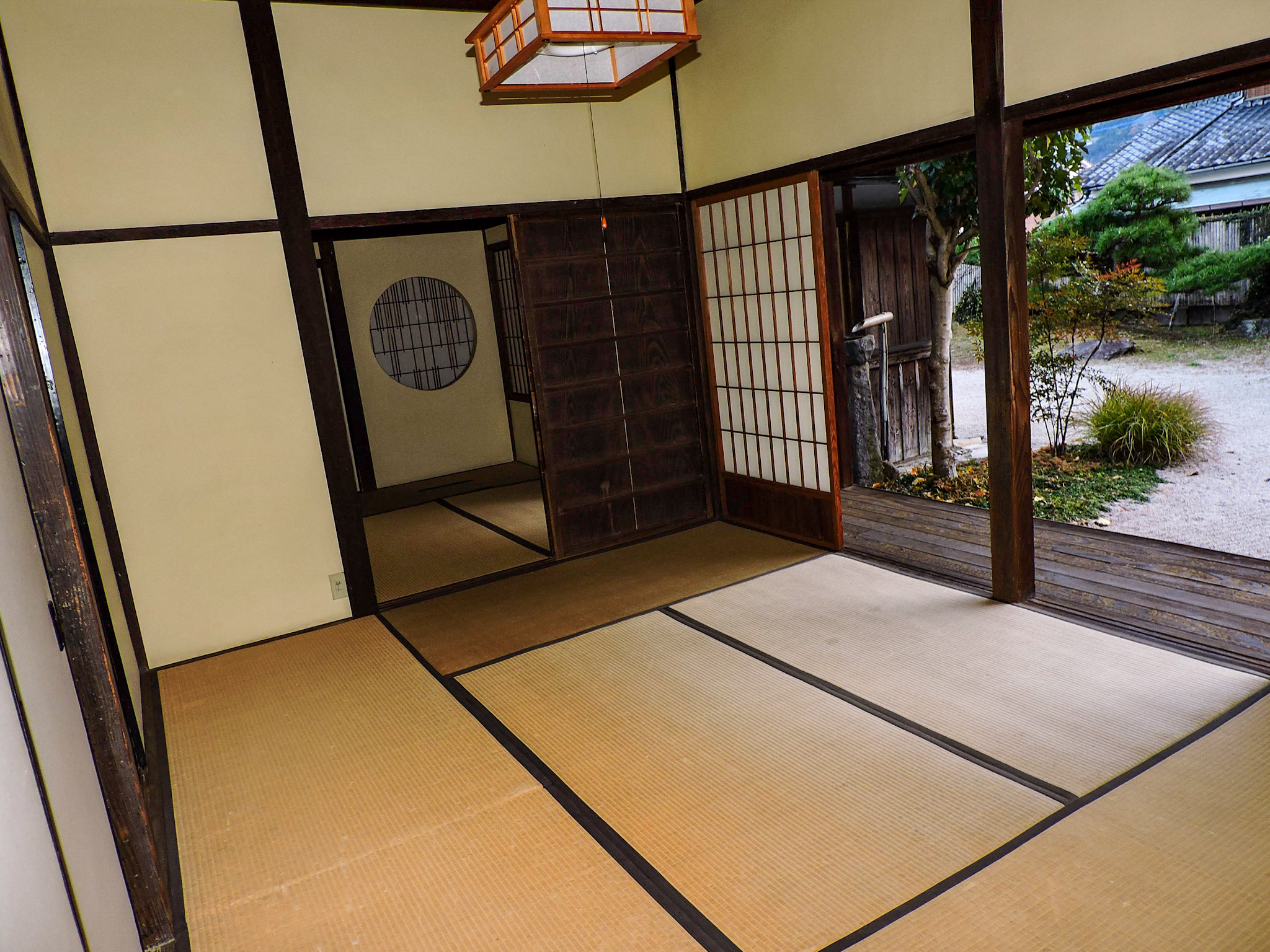 A bedroom with any furniture
A bedroom with any furniture
 Traditional fireplace
Traditional fireplace
While we are getting ready to enter the car a very nice old Austrian guy approaches us. He says he lives in the city and has been married to a Japanese women for five years. He recommends us a lovely Nepalese restaurant where we have great dinner with curries and baked naan bread.
Going back to the city we decide to treat ourselves with one more pleasurable experience – namely a hot onsen bath. The group decides to visit one of the oldest baths – Takegawara oncen which is translated as “a hot spring over the bamboo tiles”. It costs 100 yens per person. It is already 9 in the evening so in the women’s department there are just a few women.
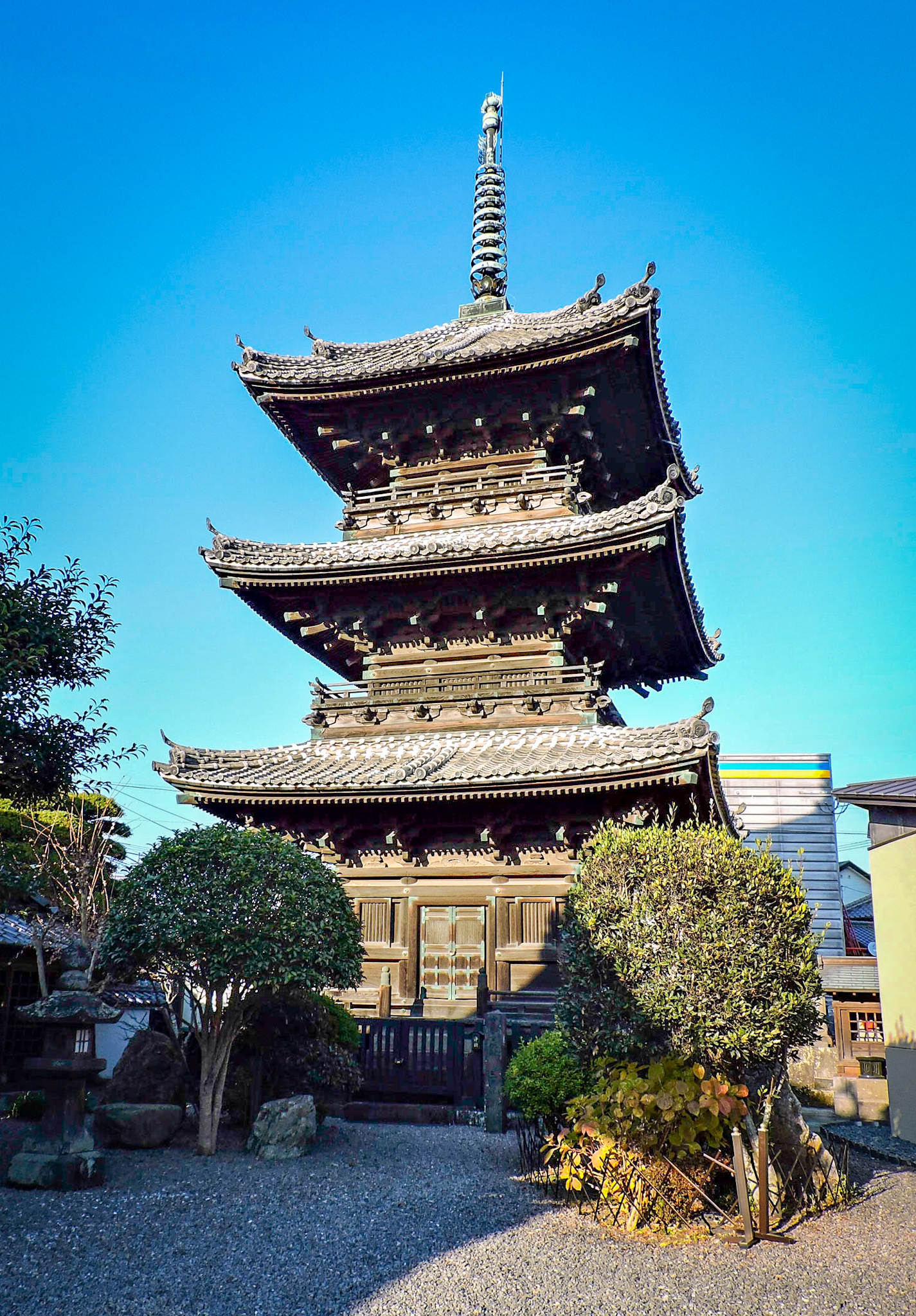 Temple tower
Temple tower
22.12
I spend the day writing the blog inside a shopping mall in the town using their free Wi-Fi. In the meantime Mr. Shushtari is on a bike searching for contact lenses for me. It turns out to be an uneasy task as in Japan you can only buy contacts if you have visited the doctor and have a prescription.
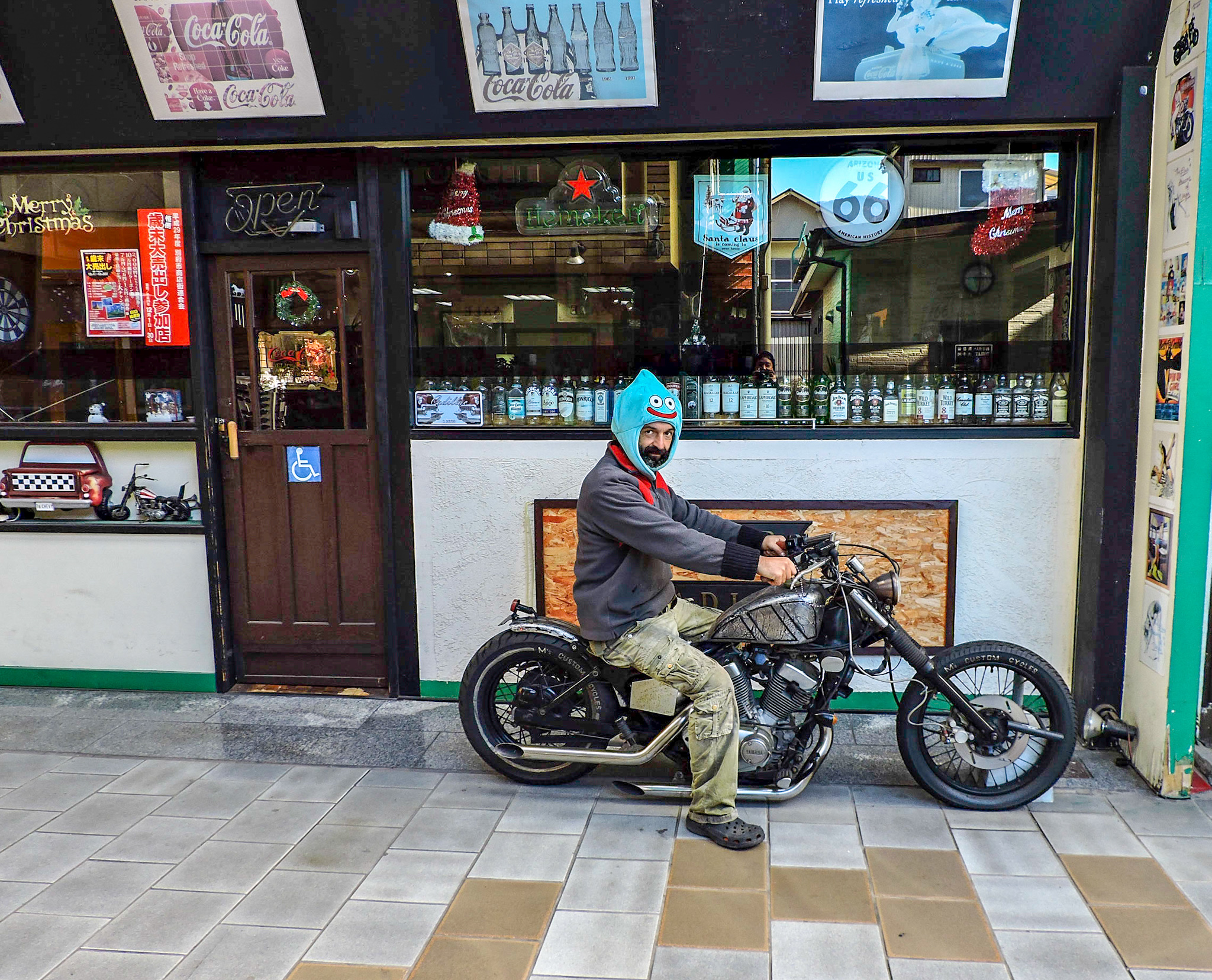 Mr. Shushtari as a manga hero
Mr. Shushtari as a manga hero
U-kil, Windy’s brother, arrives in the afternoon. He will sail with us to Korea. We buy some food that we will need for the next leg of the journey spending 200-300 USD for just a few things as the prices are so high – a single bulb of garlic for example costs 3 USD.
 Interesting products and flowers used for cooking
Interesting products and flowers used for cooking
We set sails at 10 p.m. planning to reach Tsushima – a small island that is just 100 km from Korea and are planning go spend Christmas there and then check out of Japan. The distance is 170 nautical miles and if the conditions are good we will arrive the day before Christmas.
23.12
The boat is on autopilot all night with the engine turned on. The inside sea between Kyushu and Honshu (where Tokyo is) is calm. There are no waves and the evening is quiet. During the day the sailing conditions continue to be great. There is a little bit more wind from time to time so we even set the sails. The views of the coast are not very inspiring as one mainly sees chimneys and industrial areas. In the afternoon the boat approaches the narrow canal between the two islands leading to open sea. The distance between the islands is so small that they have built a bridge.
 The bridge between Honshu and Kyoshu
The bridge between Honshu and Kyoshu
The current inside the canal is very strong but luckily it is in our direction so we manage to sail at 13 knots with hardly any wind. Soon the boat is out of the canal and there are 70 miles to Tsushima. To our relief there are no big waves or strong winds so the night is calm. This is maybe the most pleasant sailing of this journey so far as for the first time I don’t have sea sickness symptoms and can eat and walk around freely.
 Map of the journey in this blog post
Map of the journey in this blog post
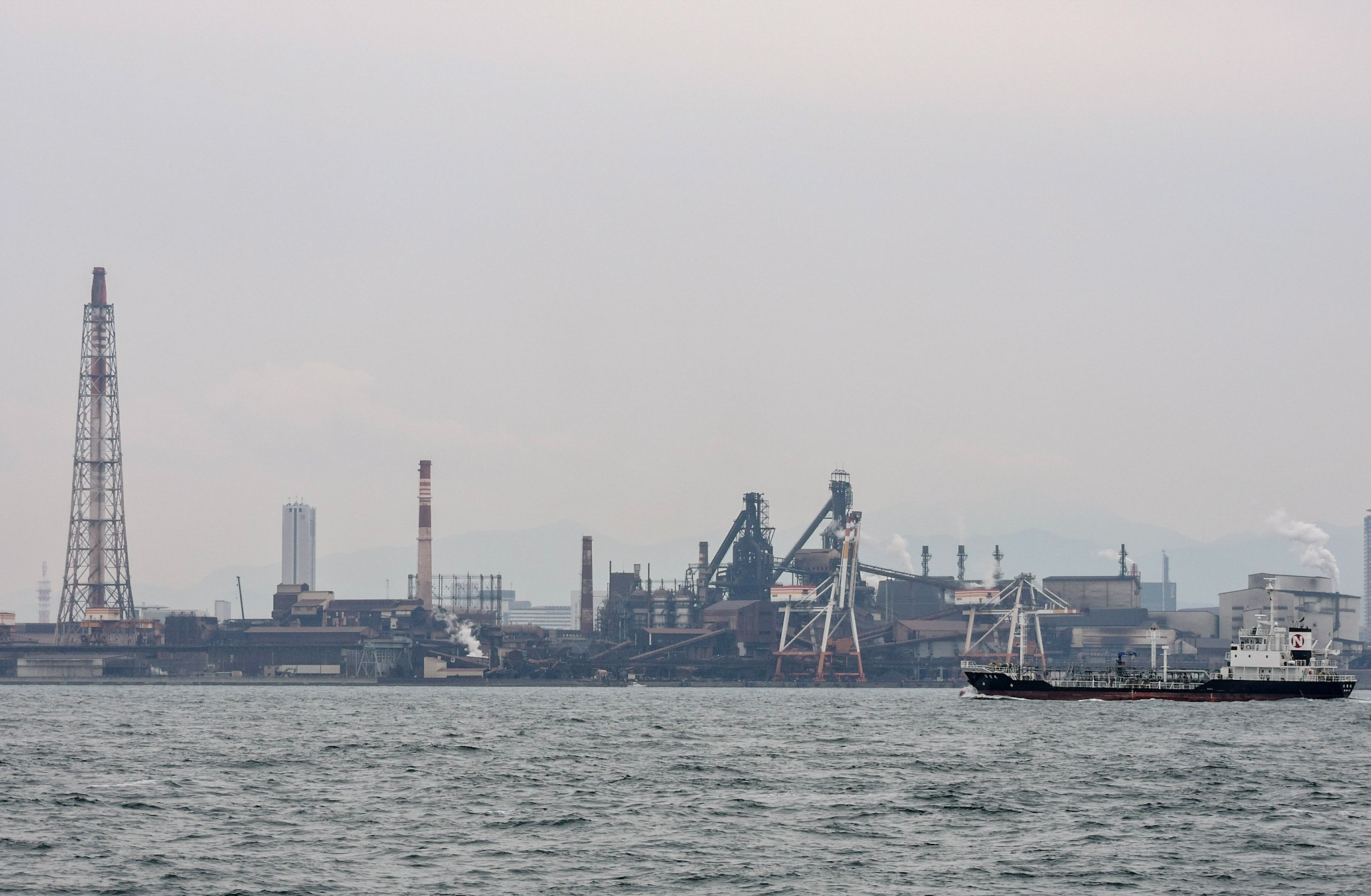 Industrial views on Honshu
Industrial views on Honshu
24.12
At 6 a.m. at Izuhara port, the main town of Tsushima is reached. It looks really beautiful with mountains, hills, pine forests and old houses. The town is pretty small, quiet and not so cold. While walking on the streets we see old temples, stone walls, Shinto sanctuaries, trimmed Japanese pine trees. Japan is a really incredible country to explore as it is so unique and its traditions are well preserved.
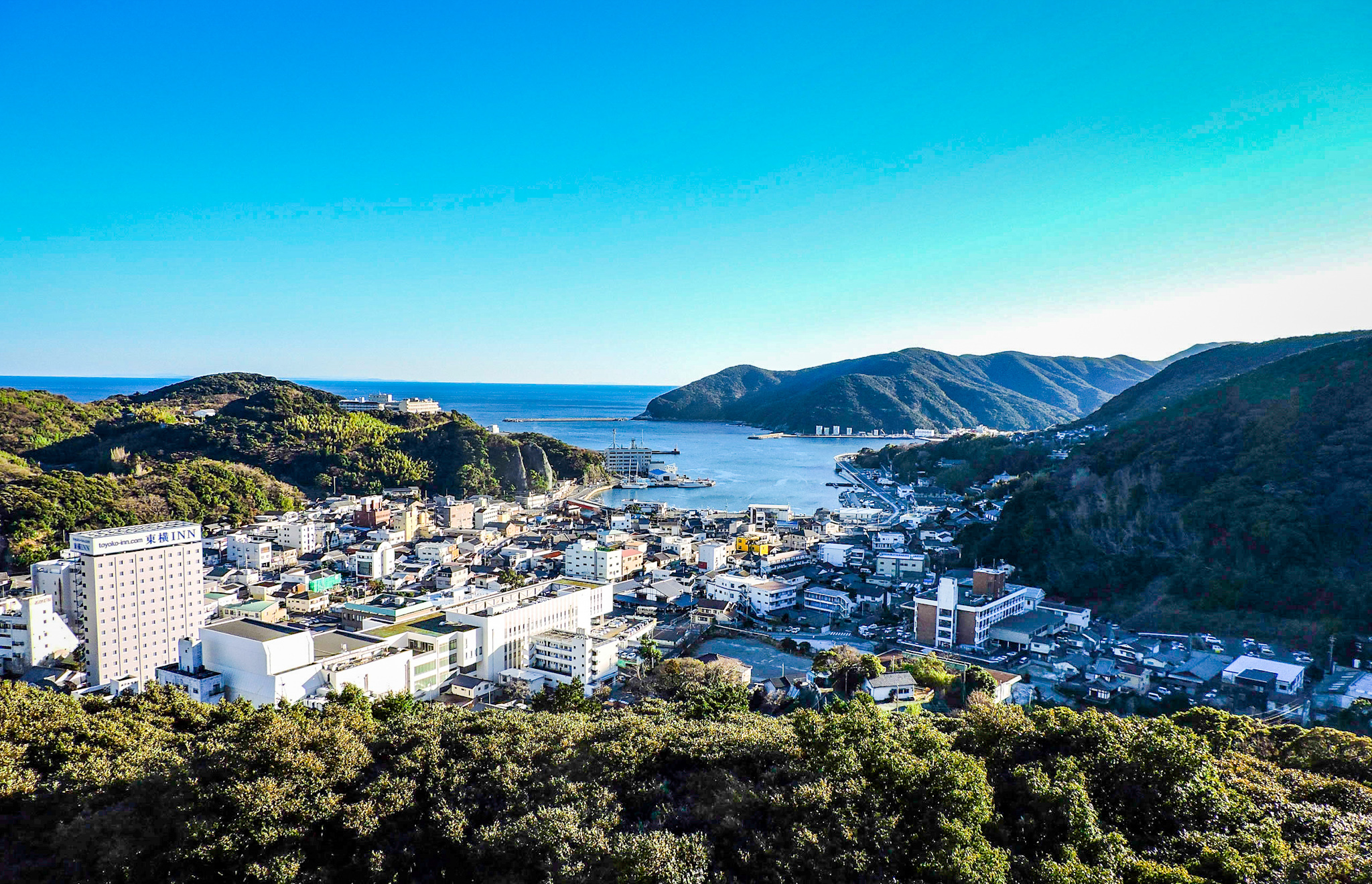 Port Izuhara
Port Izuhara
 A street in the town
A street in the town
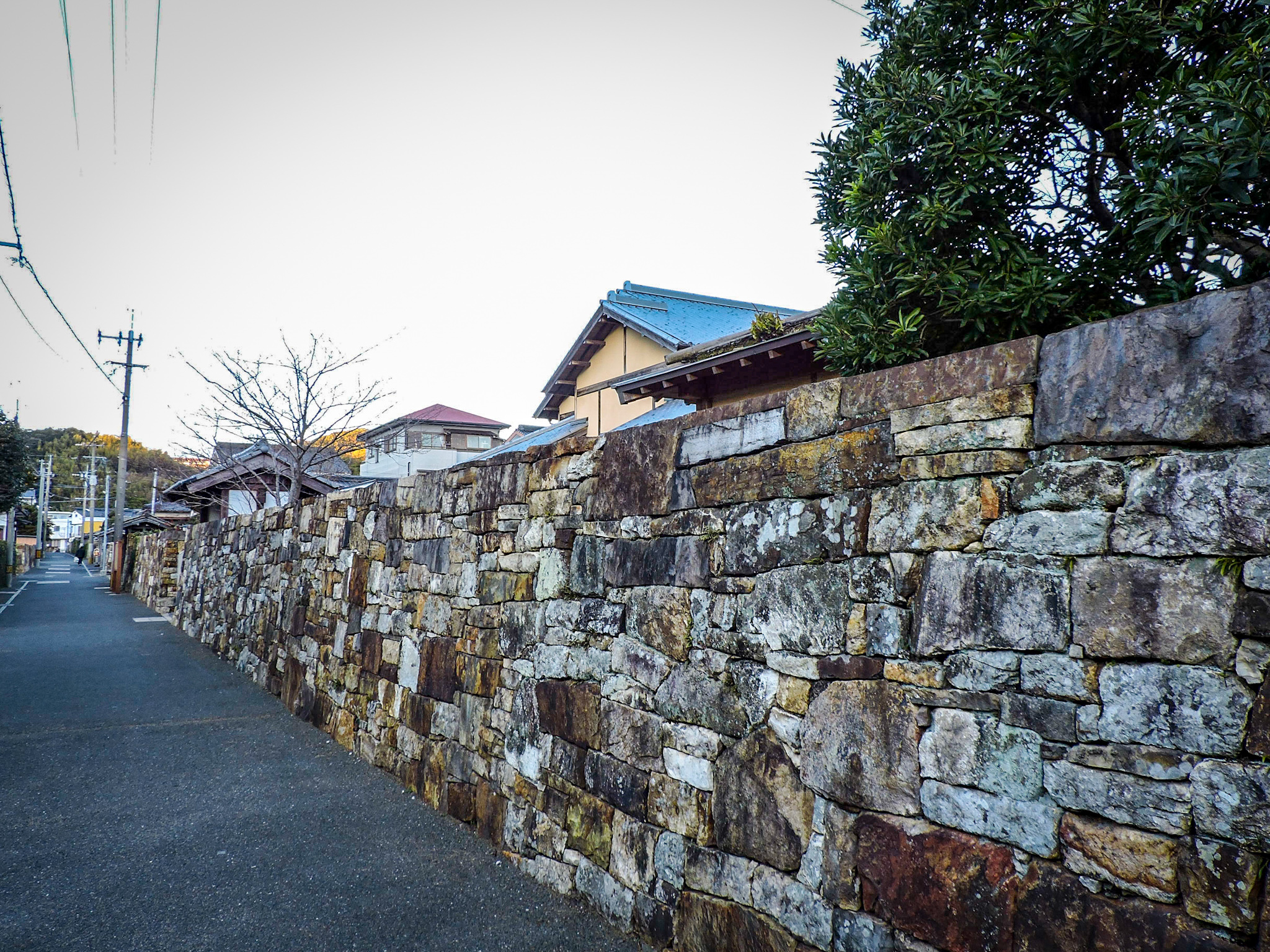 An old stone wall
An old stone wall
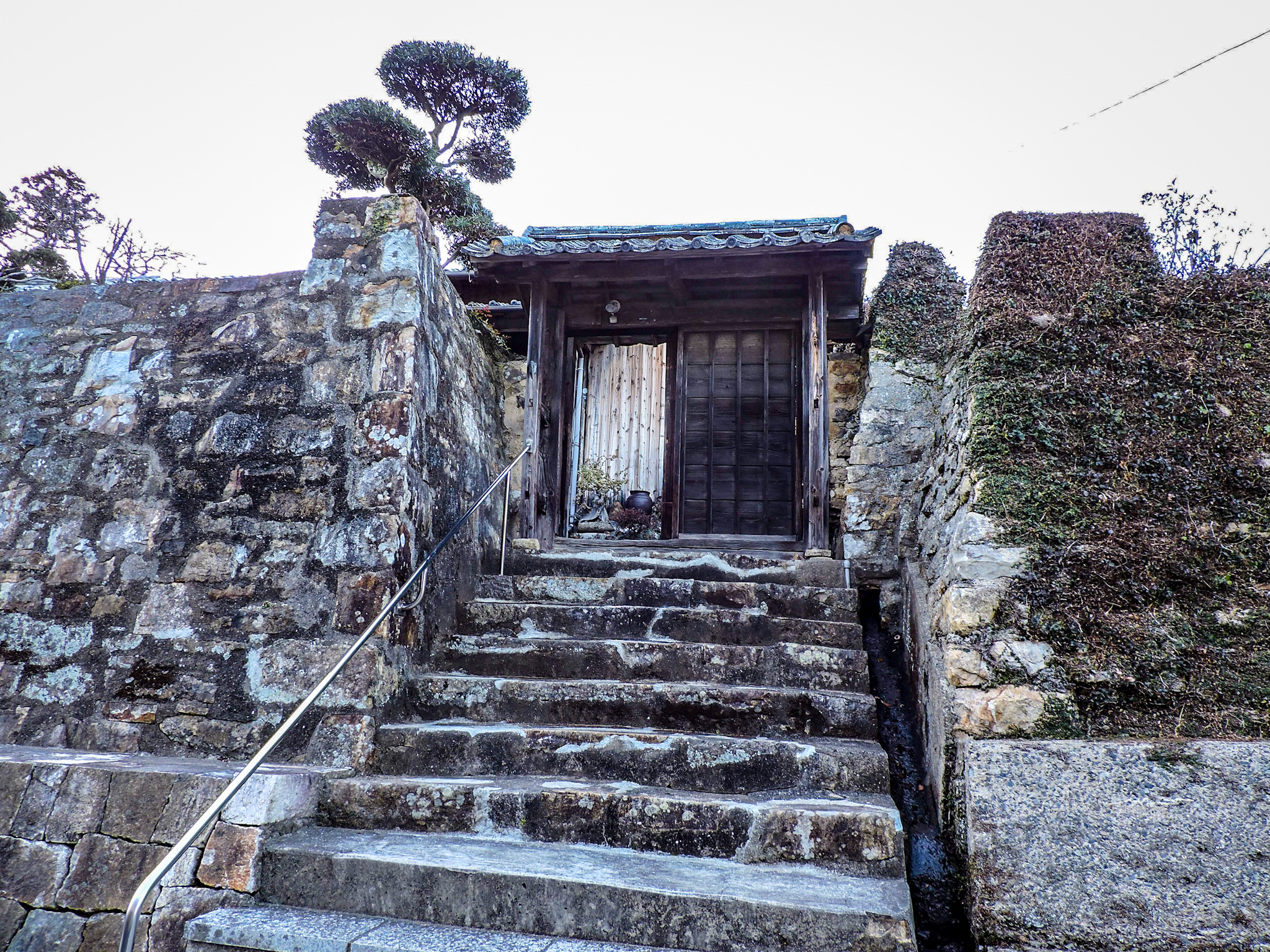 A house door
A house door
 Old temple
Old temple
While we are buying the necessary products for Christmas eve it starts pouring cats and dogs and it doesn’t look like it will stop any time soon. So we visit one tea shop, buy different high quality green teas and head back to the boat to prepare dinner. Eight hours later the table is served with 13 dishes on it (11 of which are vegetarian as the tradition in Bulgaria is). For drinking there is wine and sake. The crew is amazed by the Bulgarian feta cheese pie that we cooked. There are also peppers filled with beans, rice bites with vine leaves, Imam bayildi and more Balkan dishes. Everyone seems to be in a good mood. We start the night by saying a prayer and giving the bread to U-kil to break it as he is the oldest person on the boat at the moment. Gifts are traded among the crew and we receive thick socks from Mr. Windy with 3000 yens (30 USD) inside each pair.
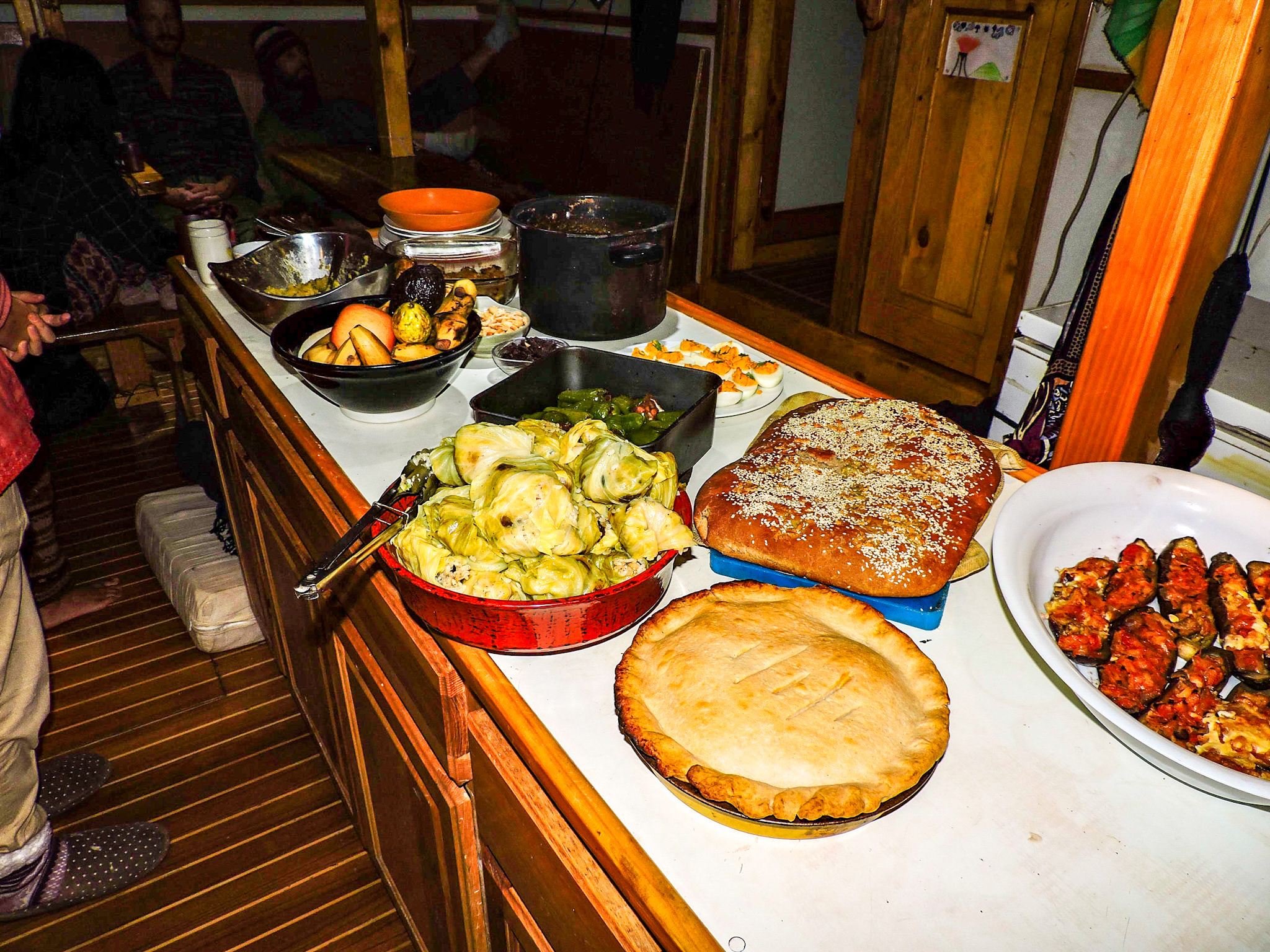 The Christmas dinner
The Christmas dinner
25.12
It is sunny on Christmas and we head to the historical town. There is a big tourist information office at the central square and we get many brochures and maps. Mr. Shushtari and I visit each temple. The ones that most impressed us are Seizanji – a zen Buddhist temple with an amazing yard and Banshoin “The temple of thousand pine trees”, the family temple of the So clan.
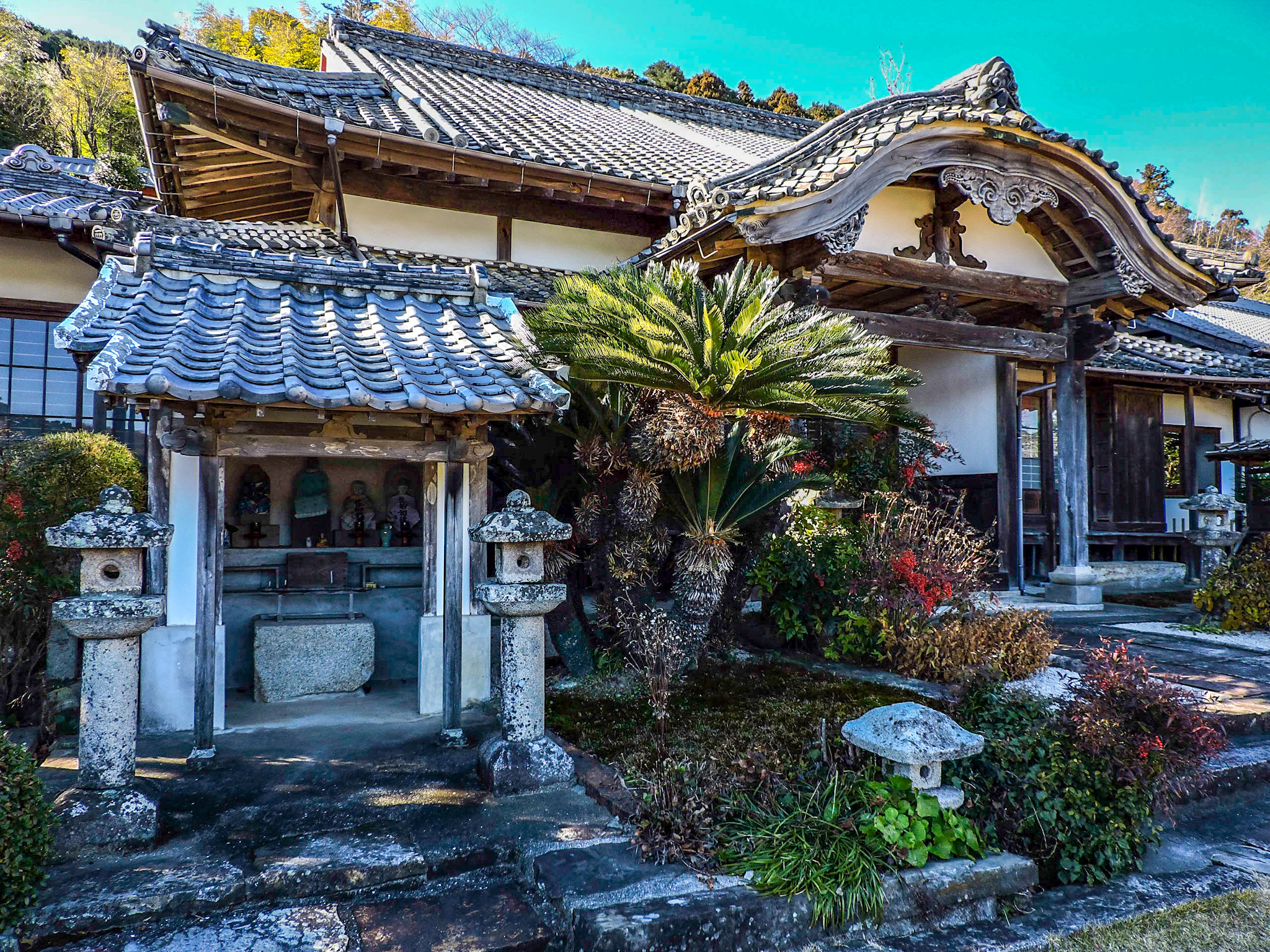 Seizanji
Seizanji
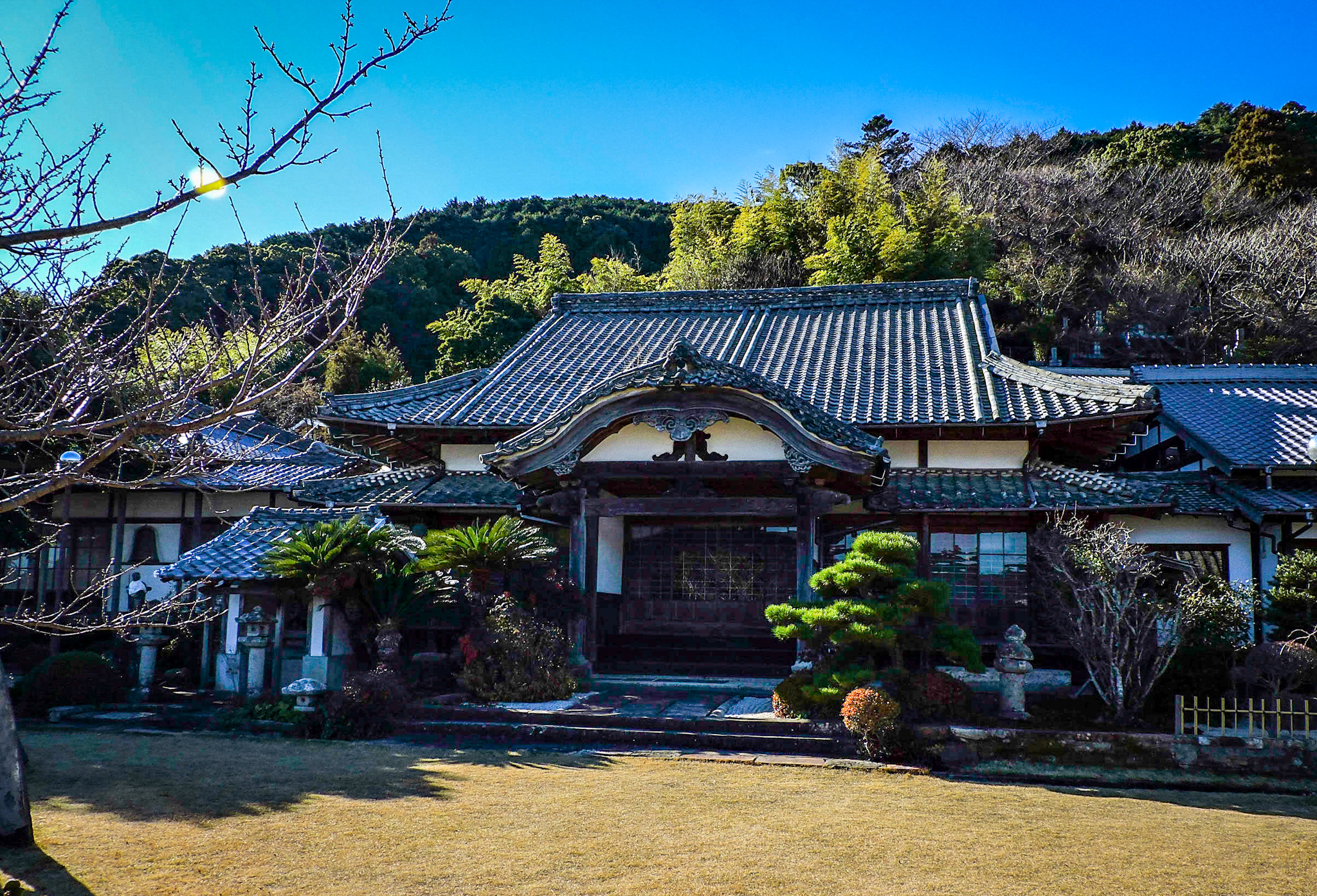
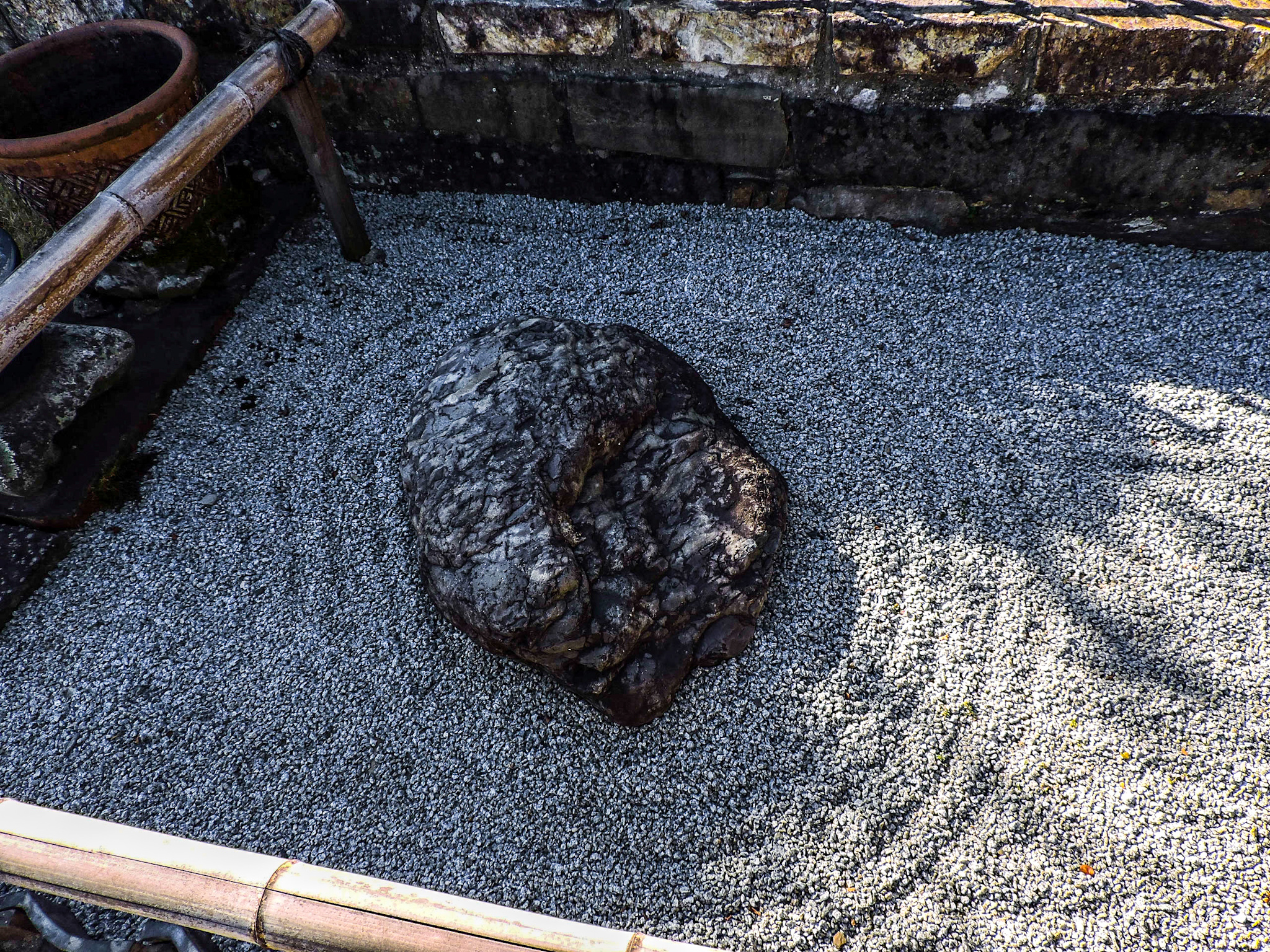 Zen art in gradening
Zen art in gradening
Interesting to know…
Tsushima island plays a vital part in the trading and diplomatic relations between Korea and Japan because of it close location to Korea. Throughout the years there have been many diplomatic delegations and the Japanese even have had an embassy in Busan, Korea at the time when Japan was closed to other countries. The island have been ruled by the samurai clan So for 700 years (from 13-th to 19-the century). What remains today is their castle, temple, graveyard and the fortified walls.
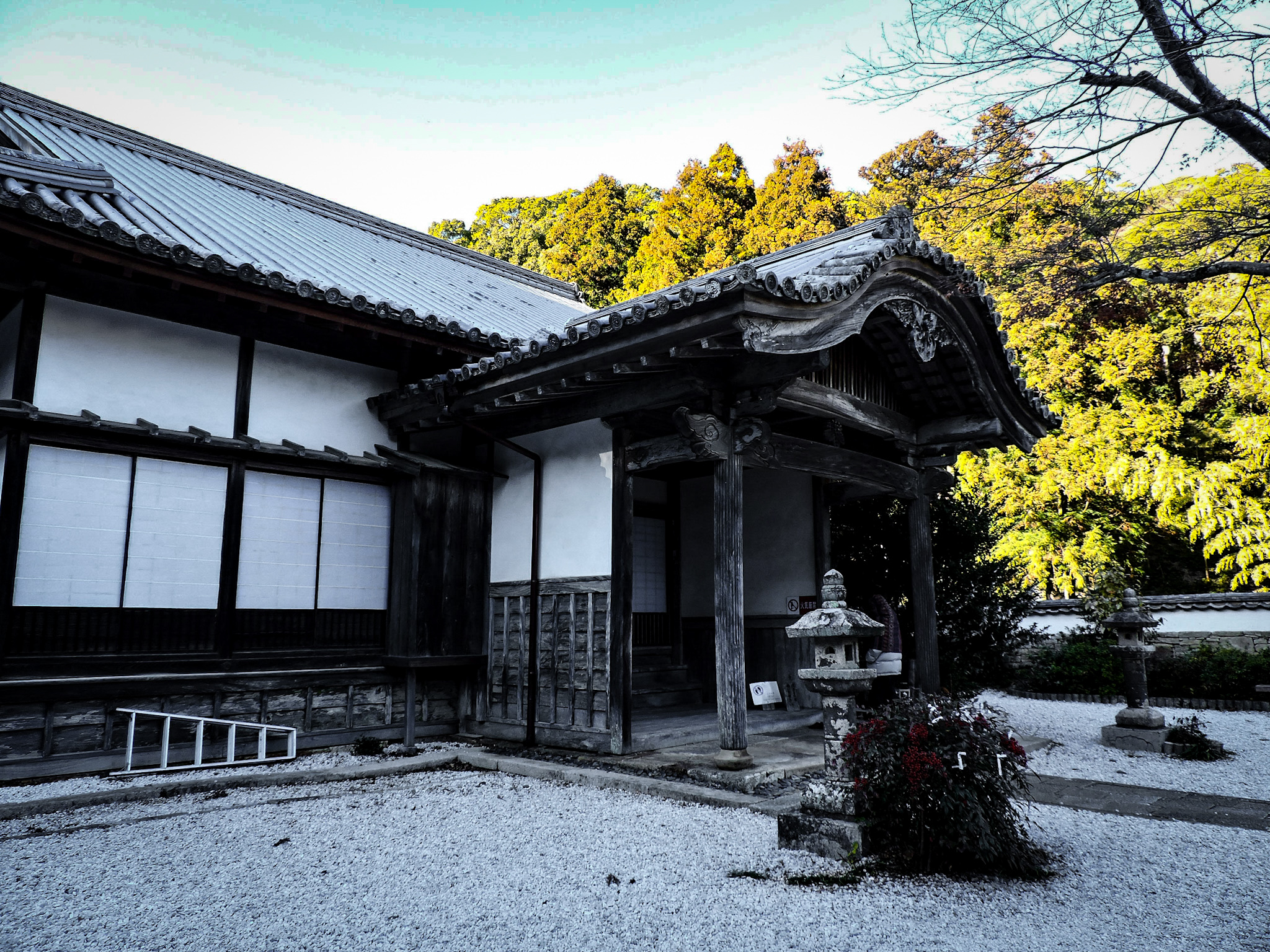 The temple of the clan So
The temple of the clan So
 The gate
The gate
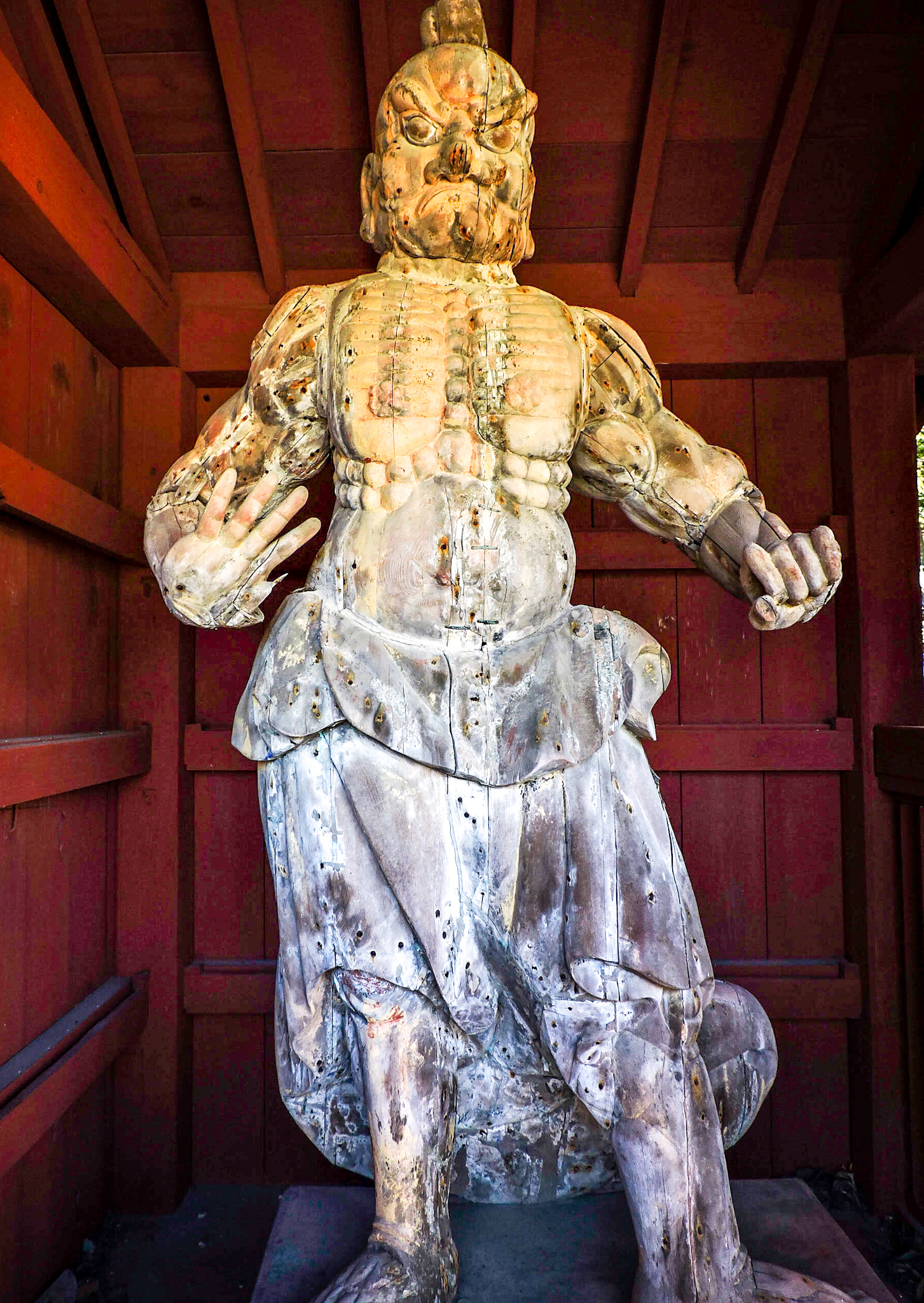 Statue of one of the temple keepers
Statue of one of the temple keepers
There are also and old neighbourhood with samurai houses and a Shinto sanctuary in the town.
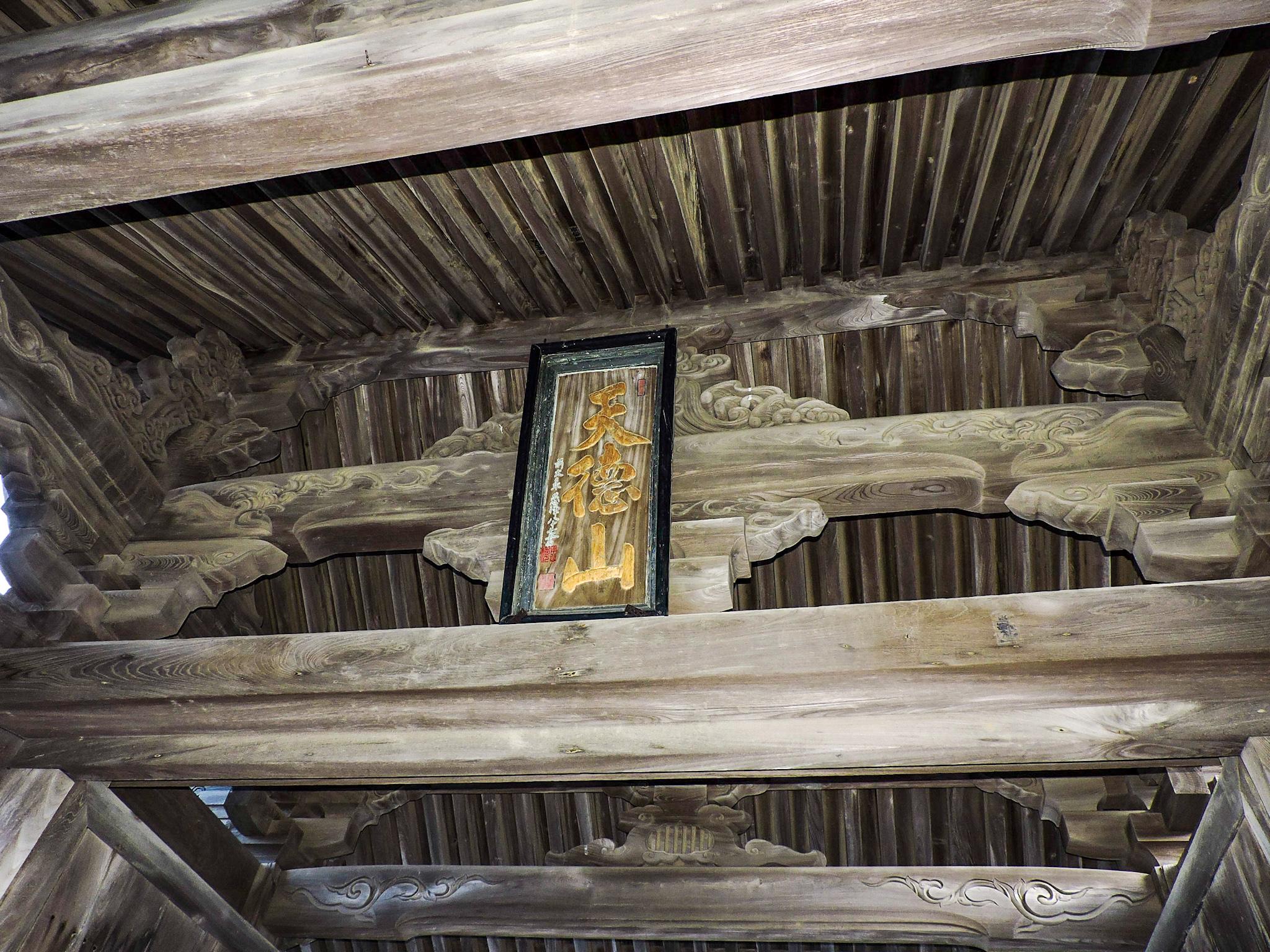 Tempe “Mountain of the heaven virtue”
Tempe “Mountain of the heaven virtue”
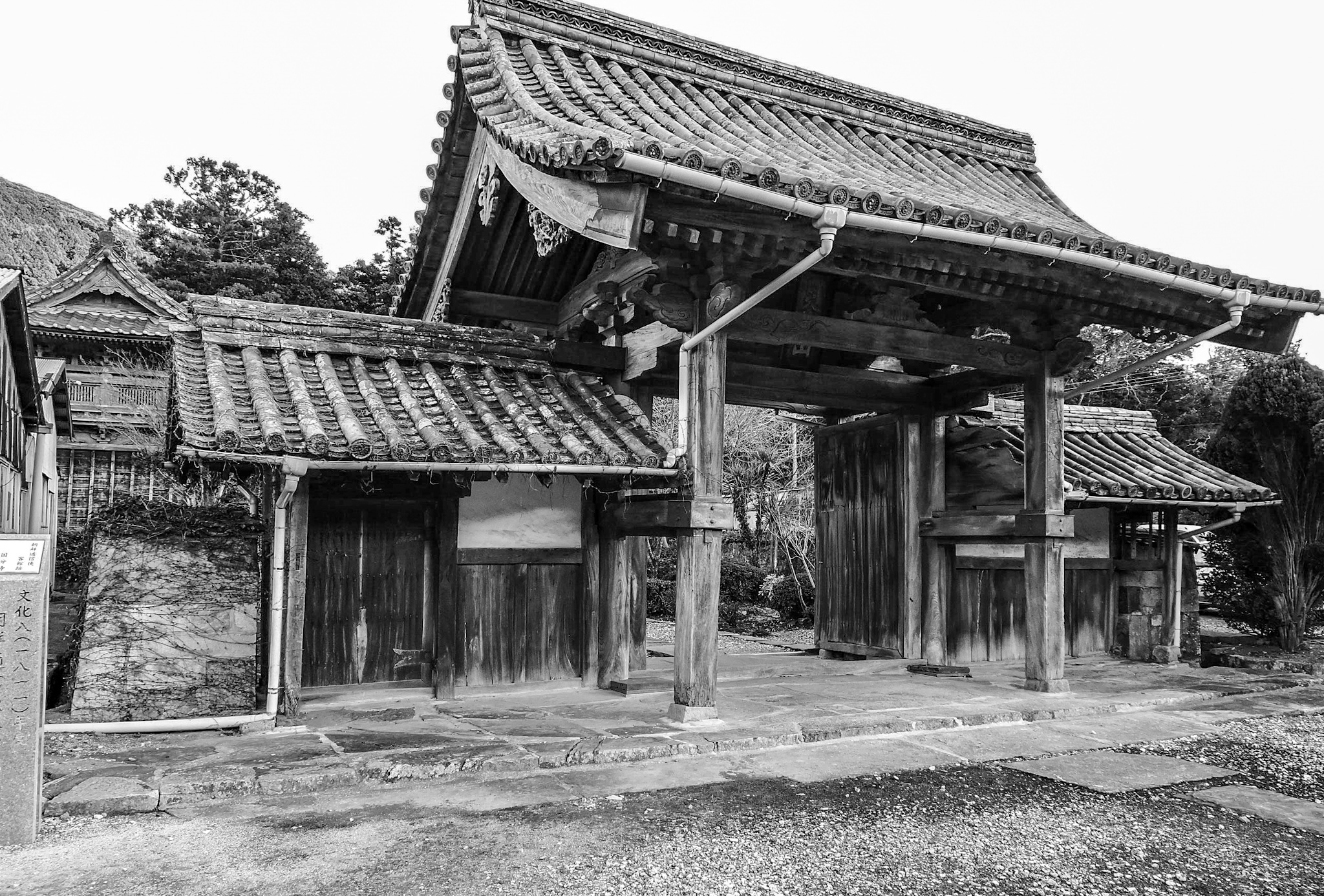 The gate of the temple
The gate of the temple
 A bell tower in the temple’s yard
A bell tower in the temple’s yard
26.12
Mr. Windy is so pleased that after 6 month of sailing from Fiji to here “Alabama” is almost delivered to Korea that he treats us again giving us money to rent two cars and see the island. It is 7 a.m. and we are ready to leave for the north part of the island. It is around 3 hours of driving and there are many interesting things to see on the way.
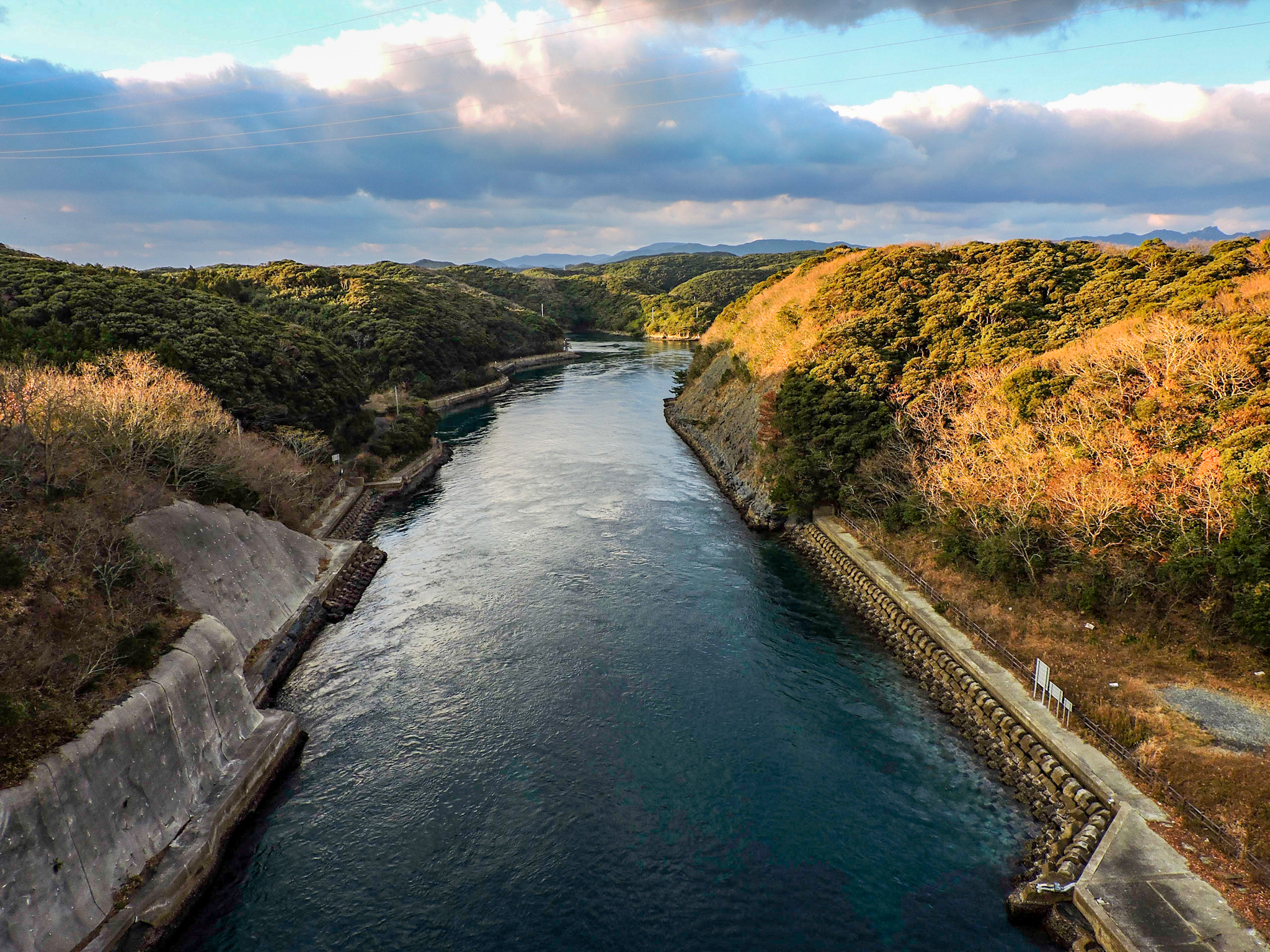 The canal between the north and the south part of the island
The canal between the north and the south part of the island
The first spot to visit is the Watatsumi shrine – one of the most important sanctuaries devoted to the god of the ocean in Japan. It has two typical tori arcs built in the water.
 Watatsumi shrine
Watatsumi shrine
Climbing the nearby hill later shows us spectacular views towards the numerous islands and canals that resemble fiords. The only down side is that buses with Korean tourists keep arriving constantly and the place gets pretty crowded.
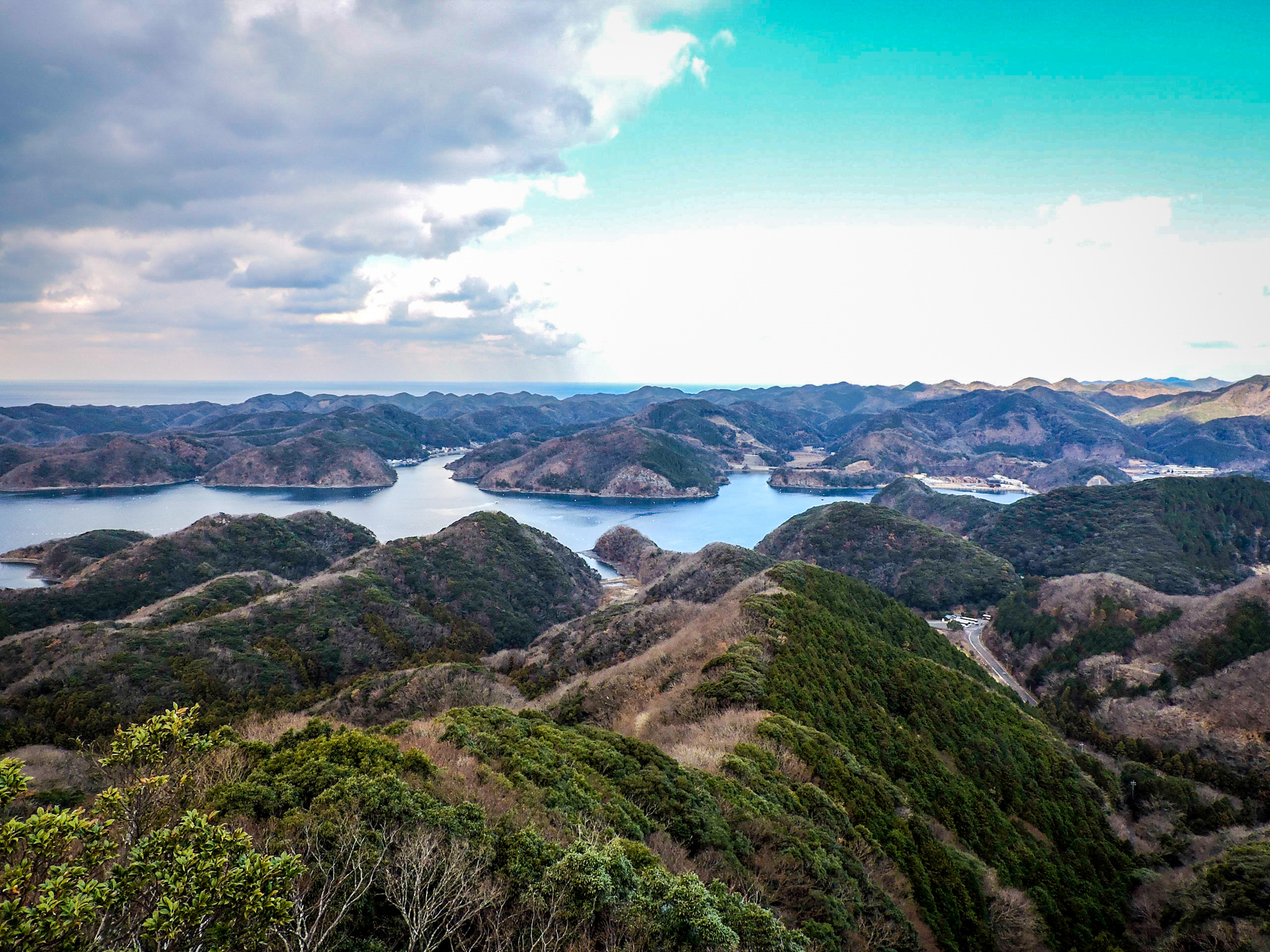
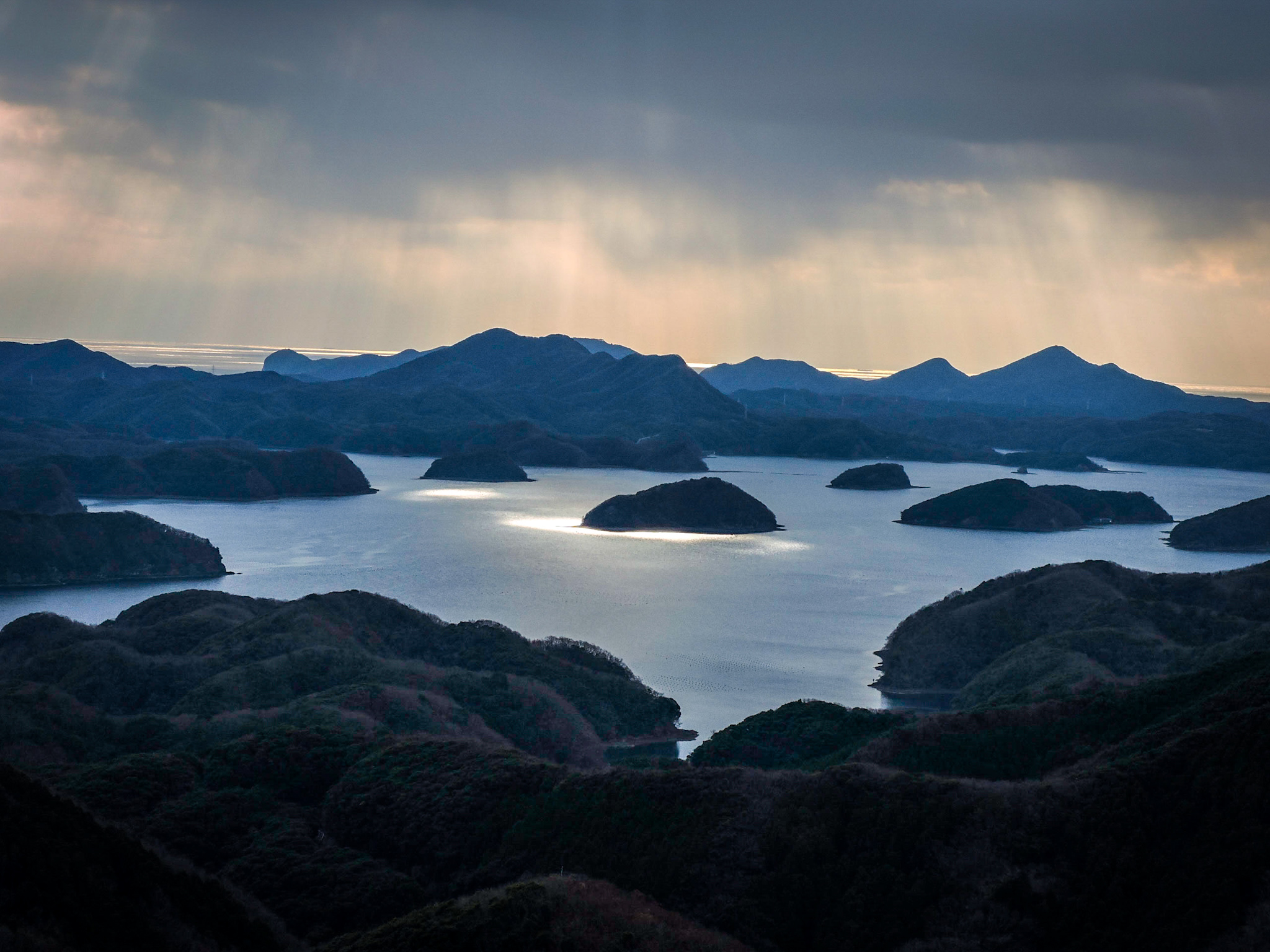 Fiords
Fiords
Our final destination is the north cape of the island where there is a specially built Korean style pavilion from which one can see Korea that is only 50 km (30 miles) away. We don’t have time to see the “Centre for protection of the wild cat of Tsushima”. The wild cat is endemic to the island and has in way become symbol of it. There are pictures of it and cat toys everywhere. Anyway we instead visit the oldest gingko biloba tree in Japan which is 1800 years old. As it is already our tradition we spend the night in a small onsen.
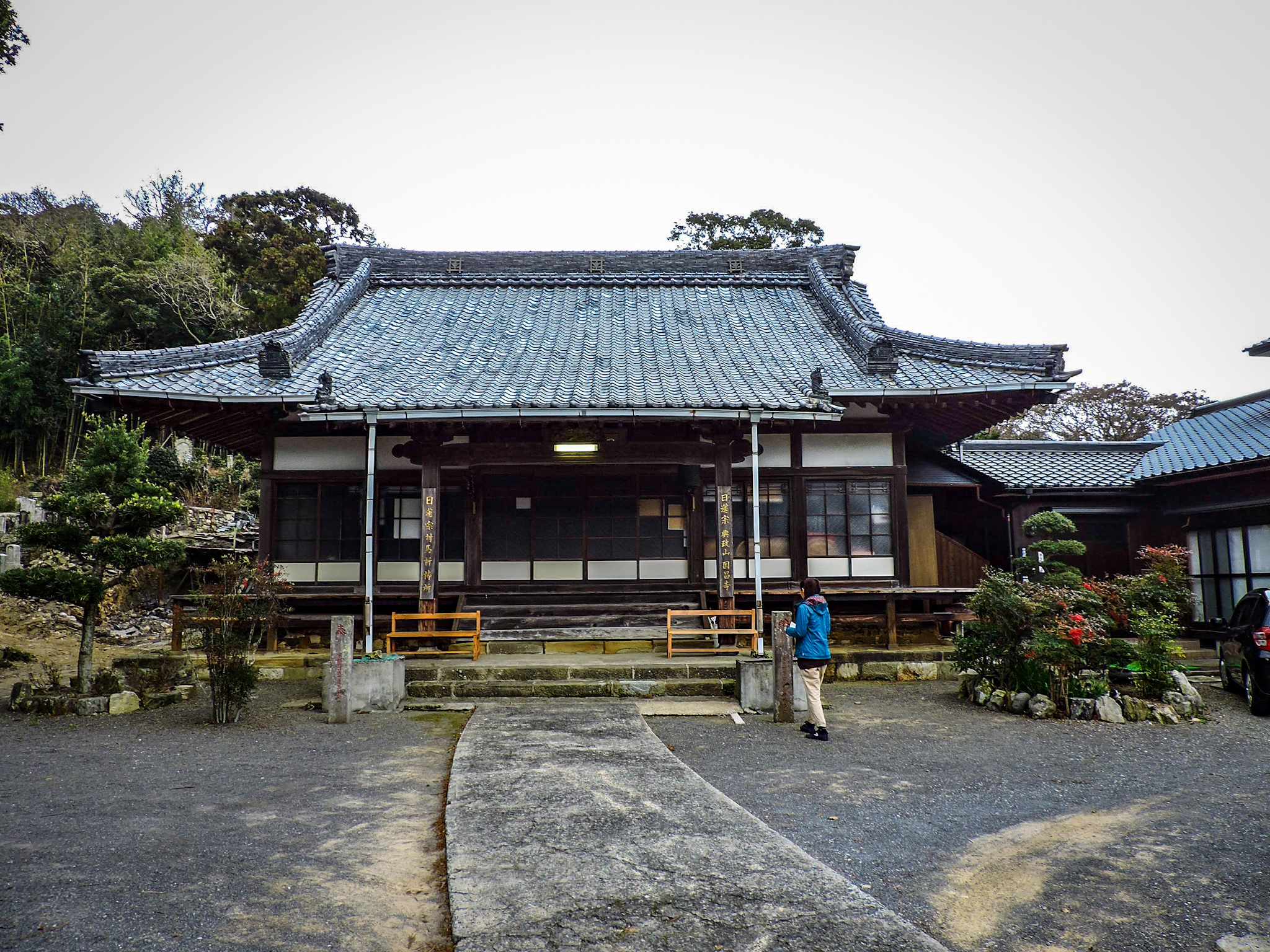 One of the many temples on Tsushima
One of the many temples on Tsushima
27.12
Today Andi, Mr. U-kil’s son joins us.
Tourist information:
Everyday there is a ferry connecting Busan, Korea and Tsushima. The journey lasts for 2 hours and costs 50 USD. From Korea there are also ferries to Fukuoka, Kyushu and Osaka, Honshu – each journey lasts several hours.
Today we will climb the nearby hill where there are remains of the Shimizuyama castle built 1600 by Tokugawa Ieyasu in order to attack Korea. The views towards Izuhara and “Alabama” are fantastic.
Then it is time to visit the impressive graveyard of the So clan with its humongous marble graves surrounded by millennial pine trees. I wonder: what the feeling of standing by the tomb of your samurai grand. grand, grand, grand dad might be 🙂
 The entrance to Bashonin temple – the family temple of the clan
The entrance to Bashonin temple – the family temple of the clan
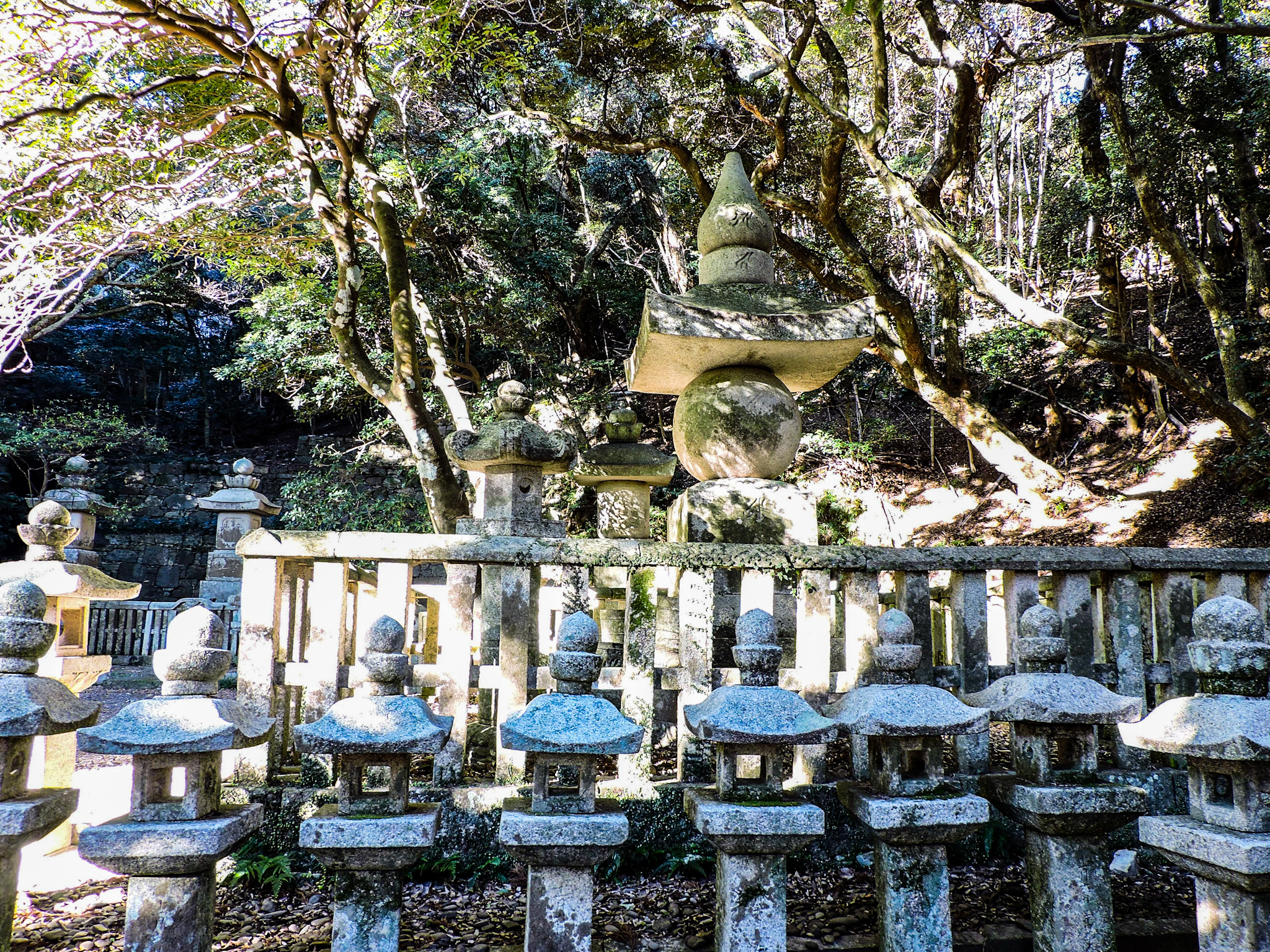 The graveyard
The graveyard
28.12
This is our last day in Japan where we have spent a month. We didn’t visit many places but everything we saw was jaw dropping. We can’t wait to come back again. Japan surpassed all the expectations and ideas we had before we came.
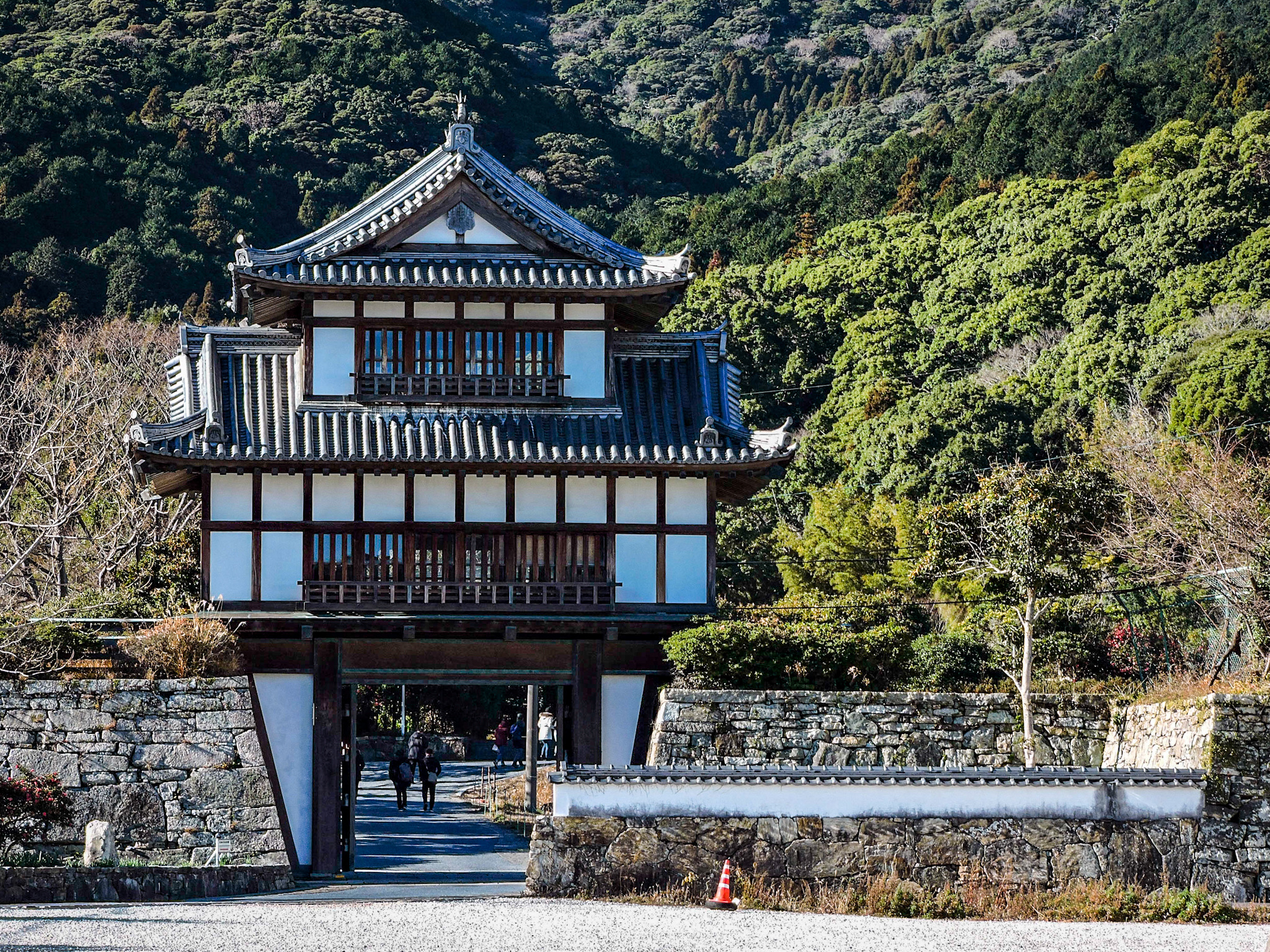 The restored gate of the fortified wall of Izuhara
The restored gate of the fortified wall of Izuhara
At noon U-kil and Adny take us to a sushi restaurant that also turns out to be flabbergasting. Among the tables there is a kind of conveyor belt on which your order arrives on a small plastic train. Each table has a built in computer where you order and so there are no waiters. You can also play a computer game and if you win you get a free drink. Andy won two times 🙂 The sushi here is scrumptious and tastes differently than the ones in all the other countries we have tried so far. The raw fish melts like butter in your mouth. We order ice cream and matcha tea for desert.
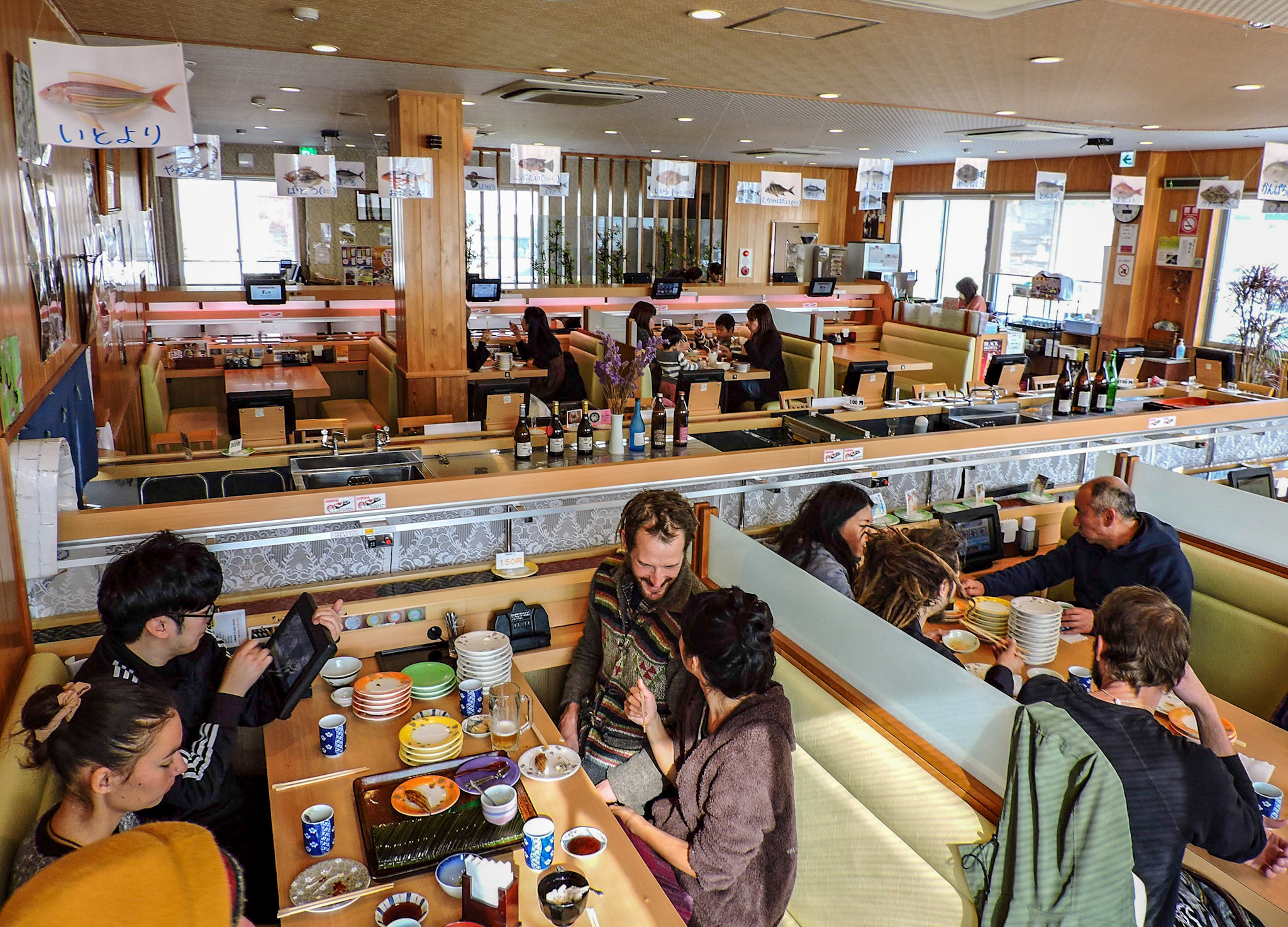 Inside the sushi restaurant, on the side is the train which brings your order
Inside the sushi restaurant, on the side is the train which brings your order
In the afternoon we check at the immigration services and prepare for the night journey which will be our last sailing trip with “Alabama”. There are 70 more miles to cross to Busan, South Korea. If all is well tomorrow we will have arrived to a new country where we will resume our travelling on land. Despite all the times I suffered sea sickness I think I will miss sailing with “Alabama”.
The sailing conditions are great and we travel all night enjoying the strong winds and lack of big waves. Before we left we had a little extreme happening as we almost hit the boat of the immigration service. During the night the last undamaged sail gets torn – the other seven have already been torn during various storms.
Early in the morning “Alabama” slowly enters the giant, very industrialized port of Busan which is the second biggest in South Korea. At this moment we successfully finish the mission to deliver the yacht after sailing for six months from Fiji to here.
 Tsushima island
Tsushima island